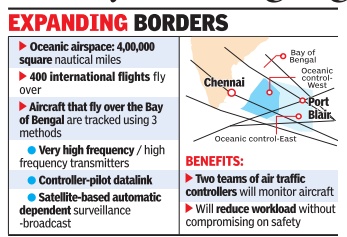Civil Aviation, India/ 1
This is a collection of articles archived for the excellence of their content. |
Accidents
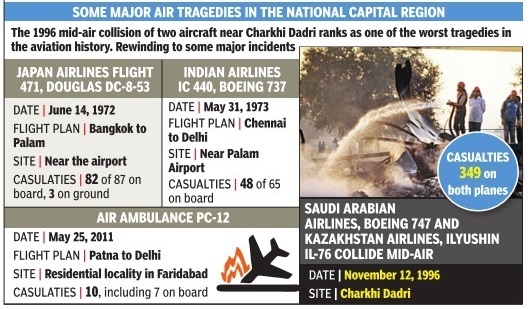
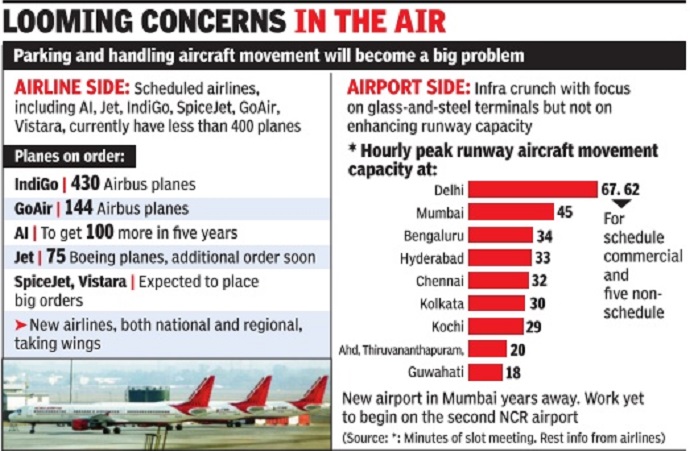
The Times of India
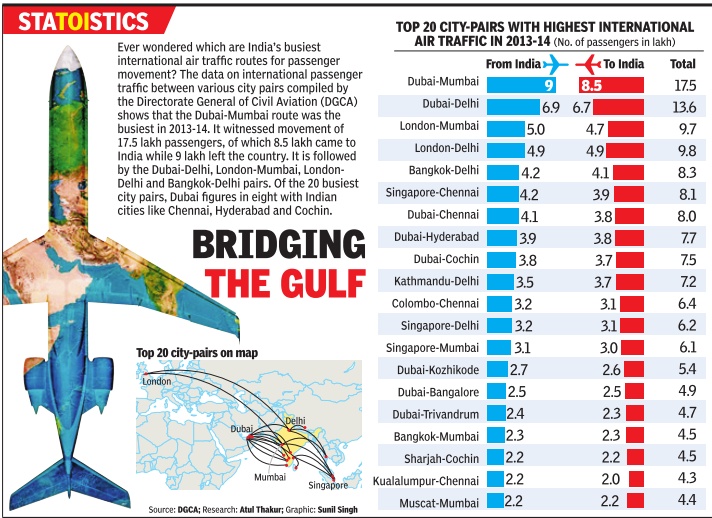
See graphics:
Some major air tragedies in the national capital region
As of Sept 2016 India’s airlines have less than 400 planes. However, they have ordered more (details above). Will Indian airports be able to handle them? This graphic gives the hourly peak runway aircraft movement at India’s Top 9 airports.
Top 20 city-pairs with highest international air traffic in 2013-14
2014-17: 87 near-misses; Delhi, Karnataka, Maharashtra top
HIGHLIGHTS
Incidents are considered “near miss” when two aircraft are so close that could it lead to compromise in their safety in air.
According to DGCA, there have been 52 such incidents between 2014 and May 2017.
According to information accessed from the Directorate General of Civil Aviation (DGCA), there have been 52 such incidents between 2014 and May 2017. Delhi (13), Maharashtra (10) and Karnataka (10) account for 50% of these, while 15 other states together account for another 50%.
Of the 52 cases, at least 35 were "near-miss" collisions.
Incidents are considered "near miss" when two aircraft are so close that could it lead to compromise in their safety in air. In one case, on March 29, 2016, all passengers on Air Mauritius flight 746 and SpiceJet flight 614 got off without realising that both aircraft came in close proximity in the Chennai International Airport airspace.
"The SpiceJet aircraft came in close proximity with landing Air Mauritius aircraft due to controller misjudgement," a DGCA inquiry found. In another case in Delhi, a wrong descend clearance given by the controller saw two aircraft — one landing and another taking off — very close, while crew members of a JetLite flight not following the proper missed approach procedure put the aircraft very close to another one. Both cases were reported in February 2016.
From miscommunication to wrongly assigning instructions, there have been varied reasons for such near mishaps and the DGCA has investigated every case.
A serious mishap involving a Sri Lankan Airlines aircraft, which was only avoided by a last-minute corrective measure on March 10, 2015, even prompted DGCA to issue a circular asking airports to change confusing call-signs. The controller had assigned a wrong left turn to a Jet Airways flight 2764 instead of the Sri Lankan Airlines flight, which could have led to a major mishap.
From proficiency checks for pilots and Air Traffic Controllers to simulator training, the DGCA said it has put in place 11 corrective measures to prevent such incidents.
2018-Jan 2020: 22 engine snags on IndiGo
Saurabh Sinha, January 24, 2020: The Times of India
NEW DELHI: Yet another snag-prone Pratt and Whitney engine (PW) of IndiGo A320 Neo stalled soon after taking off from Mumbai for Hyderabad as 6E-5384. While passing flight level 23,000 feet, one of the engines experienced the now common high vibration with a loud bang sound, stalled and had to be shut down.
Since twin-engine planes can land safely on one engine, this Neo (VT-IJD) with just over 100 people on board made a safe emergency landing in Mumbai at 1.39 am — less than an hour after taking off from there at 12.43 am. This is the 22nd snag of PW engines on IndiGo Neos in last two years.
“During ground inspection, low pressure turbine number 3 of engine number 1 that had done 4,006 hours was found damaged. The Neo is grounded in Mumbai. The other engine was a modified one that had done only 1,198 hours and the plane had landed safely on that,” said a person investigating the latest trouble. An IndiGo spokesperson said flight 6E-5384 (A320) with 95 passengers “operating Mumbai Hyderabad had an air turn back to Mumbai. During the flight, the pilot observed an engine caution message and followed the laid-down standard operating procedures. The aircraft returned to Mumbai and is under inspection at the Mumbai airport. All passengers were accommodated on another flight to Hyderabad.”
Comments from PW have been sought and are awaited.
In the past few days there has again been a spurt in PW engine snags on A320 Neos. People in the know say that such issues are likely to keep happening till the unmodified and more snag-prone PW engines of the Neos are replaced. But airlines and aviation regulators say they have taken steps to ensure safety till that happens.
“The Directorate General of Civil Aviation (DGCA) has insisted and ensured that NO A320 Neo flying with PW engines — a combination used by IndiGo and GoAir — has both unmodified engines. The Neos in India, 106 with IndiGo and 41 with GoAir, have at least one modified engine each under their wings. So while the unmodified PW engine may stall inflight, the modified one will ensure the aircraft lands safely,” said a source.
The decision to allow Airbus A320/321 Neos with IndiGo and GoAir to operate only if they have at least one modified — and hopefully less snag-prone PW engine — has saved the day on multiple occasions as there have been numerous instances on the unmodified Pratt engine going bust and then the Neos landing safely on the one modified engine.
IndiGo needs to change about 137 unmodified PW engines on the A320/321 Neos in its fleet. This means of the 106 A320/321 Neos in IndiGo fleet currently, about 70 require an engine replacement. The DGCA has extended the January 31, 2020, deadline for having only modified PW engines on all its Airbus A320/321 Neos by four months to May 31. The regulator has stressed that no IndiGo Neo will be allowed fly after that if it still has an unmodified PW engine.
While PW has not commented on the recurring snags on its Neo engines for some time now, IndiGo — the world’s biggest customer of A320 family of Neos with 106 in fleet and over 650 on order — on January 17, 2020, sent a detailed response on this issue.
IndiGo statement of January 17 said: “There are around 560 plus Neo operating with PW-1100G engines with 36 airlines. Globally these aircraft have logged over 20 lakh hours and over 10 lakh cycles (flights). New product and design are associated with issues which get manifested in-service. There have been issues with low pressure turbine stage 3 of Pratt engines. Pratt has identified the root cause and developed a fix with modified low pressure turbine blades made of Inconel. This fix has been implemented since May 2019. All new engines and spare engines currently being delivered are with modified LPT.”
“In order to ensure continued safety of operation, Airbus and engines manufacturer and various regulatory authorities like DGCA in India, FAA in US and EASA of Europe have issued directives. Directives of DGCA are much more stringent than FAA and EASA. IndiGo Neo fleet is in full compliance with DGCA directives. At present, none of our Neo aircraft have both unmodified engines i.e. each aircraft either have both engines modified or at least one engine is modified. We have achieved that EASA guideline 2.5 months prior to the EASA deadline of March 31, 2020. Further IndiGo is working with original equipment manufacturer to ensure that 100% of IndiGo Neo fleet will have modified engines within the DGCA stipulated timelines which is much ahead of the FAA time line,” the IndiGo Jan 17 statement added.
Acquisition, purchase of aircraft
June 2016: Importing older planes
The Hindu, June 27, 2016
Airlines can now import older planes
Domestic airlines can now import aircraft that are up to 18 years old into the country with the government amending more than two-decade rules in this regard.
The move is expected to provide a fillip for the government’s ambitious efforts to boost regional air connectivity as it gives more leeway for operators in expanding their fleet.
Till now, aircraft that are more than 15 years old were not allowed to be imported.
Doing business
As part of larger efforts to improve the ease of doing business in the domestic aviation sector, which has huge growth potential, the Directorate General of Civil Aviation (DGCA) has made changes to rules that had come into effect way back in July 1993.
With the revised norms, pressurised aircraft that are not over 18 years old or those which have not completed 50 per cent of design economic pressurisation cycle can be imported.
A pressurised aircraft is one which is equipped to handle cabin pressure at an altitude of above 10,000 feet.
Such planes should not have completed “15 years of age or 75 per cent of design economic life or 45,000 pressurisation cycle.”
The regulations would be applicable for entities having scheduled, non-scheduled and general aviation operations.
“Considering that modern commercial air transport jet aircraft are significant economic assets that can have an effective economic useful life of decades, the restriction imposed on import of aged aircraft is cautiously revised,” the latest CAR signed by DGCA chief M Sathiyavathy said.
Civil Aviation Requirements: CAR
In this regard, changes have been made in the relevant norms or Civil Aviation Requirements (CAR) effective from June 17.
“Aircraft intended to be imported for air cargo operations shall not have completed 25 years in age or 75 per cent of its design economic cycles or 45,000 landing cycles,” it noted.
The regulator also said that studies were conducted by international aviation community on the correlation between fatal accidents and age of the aircraft.
“Such studies have not clearly established that there is a correlation between accident rate and aircraft age up till 18 years,” it added.
Unpressurised aircraft
With respect to unpressurised aircraft, the decision would be taken on a case to case basis after examining the record of the plane that is to be procured from overseas.
“However, DGCA would normally not allow such aircraft which are more than 20 years old,” it said.
The watchdog noted that aircraft intended to be imported and used for scheduled commercial operations should have their design economic calendar and operational life clearly established by the holder of type certificate, among other requirements. Aircraft manufacturers usually prescribe design standards.
2017: India 3rd biggest buyer
Manju V, With 1,080 aircraft orders, India to be 3rd largest buyer, June 2, 2017: The Times of India

Report Voices Concern Over Congestion, Infrastructure
With over 1,000 aircraft set to be on order, India is poised to become the third-largest buyer of commercial passenger planes in the world, with only the US and China ahead of it. The aircraft order book of the Indian airline industry will soon touch 1,080, which would mean that for every aircraft in service, there will be 2.2 aircraft on order, said a report released by the Centre for Asia Pacific Aviation (CAPA), a Sydney-based aviation think tank.
There are an estimated 480-odd aircraft in the country at present.
Currently , a total of 880 aircraft are on order, with most of the orders placed by low-cost carriers such as IndiGo and SpiceJet (see graphic).
In the coming weeks, full service carriers Jet Airways and Vistara are expected to add to the tally and take the total order placed by Indian carriers to a four-digit number. The 2.2 ratio would be the highest of any major aviation market in the world.
But what should have the government and airport operators worried is that of the expected 1,080 aircraft, more than 700 are scheduled for delivery within the next decade, and 400 within the next five years. This excludes orders yet to be placed and equipment to be taken on lease.
“In addition to the incumbent carriers, it is possible that India might see the entry of 1-2 new large start-ups, including Qatar Airways' proposed venture.Aircraft induction on this scale will require massive infrastructure development, skilled resources and aircraft financing at a pace that has not been seen before in India,“ said the CAPA report.
The CAPA report pointed out that airport infrastructure challenges could constrain growth and lead to suboptimal operations and network economics.
“Parking bays and runway slots will become increasingly scarce over the next few years, especially at metro airports. Signs of congestion are already emerging at Mumbai, Chennai and Delhi and the situation will become more acute unless airports are able to construct 400 parking bays and enhance airside capacity within five years. Otherwise airlines will face challenges in implementing their base and network plans,“ the report said.
In March, India became the third-largest domestic aviation market in the world, beating Japan. India's domestic air passenger traffic stood at 100 million in 2016 and was behind only the US (719 million) and China (436 million). In contrast, though, is the poor infrastructure growth. In the year ended March 31, 2017, Mumbai airport beat London's Gatwick to become the world's busiest airport with a single runway .
The other concern comes from safety risks the growth would bring about. “The projected industry growth rates will heighten safety risks due to the regulator being over-stretched. Institutional strengthening of the DGCA is a national interest issue.If unaddressed, another downgrade by the FAA (Federal Aviation Administration, US's civil aviation regulator) cannot be ruled out.
India's regulator, the DGCA, will struggle to provide adequate regulatory oversight for the projected size of the market,“ said the report, adding that the DGCA is already under-resourced and short of expertise to meet current requirements, let alone future growth.
“The increase in airprox incidents (when two aircraft are within 30 seconds of colliding with each other) in the last 12 months is a concern.In addition, it will be stretched by the entry of new operators and equipment as a result of the launch of the Regional Connectivity Scheme.If oversight capabilities are left unaddressed, another FAA downgrade to Category 2 is not out of the question,“ it warned.
For airlines, the way ahead is turbulent, with pilot poaching set to become a serious challenge. The DGCA is likely to increase the notice period for pilots to exit from six to 12 months.
The report zeroed in on low-cost carrier IndiGo, stating that the airline's insatiable demand for crew to support its rapidly expanding fleet, and its strong financial reserves which allow it to fund a hold pool of pilots, has it leading the way in poaching crew.
Aerial advertising/ banner towing
2019/ allowed in India
Saurabh Sinha, Dec 5, 2019 Times of India
Aerial advertising with low-flying single engine turboprops and helicopters flying low — called banner towing — will now be allowed in India. In a first, the Directorate General of Civil Aviation (DGCA) has enacted rules to enable this after “some operators have shown interest in engaging in this activity in India.”
Officials say the main use will be for low flying over unpopulated areas. With more stringent safety conditions, these machines could also be used over staid during ticket matches. The rules say banner towing will not be carried out over “congested areas of a city, town or settlement or over any open air assembly of persons at altitudes lower than 1,000 feet above the highest obstacle within a horizontal radius of 2,000 feet of the aircraft.”
Airlines
See Airlines: India
Manju V, April 29, 2022: The Times of India
Mumbai: Satellites have been helping motorists navigate their way to destinations for decades now, but on Thursday, for the first time in Asia-Pacific, the very same constellation of satellites that offers GPS teamed up with three ISRO satellites to provide navigation guidance to pilots who landed their aircraft safely on to the Ajmer airport runway in a successful trial flight. The Airports Authority of India said the successful trial was a major “air navigation services” milestone in India’s civil aviation history. Currently, air navigation services are provided by ground-based systems.
IndiGo airline carried out the test flight with its ATR aircraft that departed from Delhi for Ajmer’s Kishangarh airport, piloted by Captain Sandip Sud and Capt Satish Veera. The satellite-based navigation system, evocatively called GAGAN (GPS Aided GEO Augmented Navigation) offers almost the same accuracy as a ground-based land- ing system. The one difference though was that the said ground-based system called CAT-I ILS has a “decision height” of 200 feet. It’s the height at which pilots should discontinue the descent to land if they have not yet spotted the runway. But the decision height for the trial flight was set higher, at 250 feet.
The Indigo pilots used the ‘Localiser Performance with Vertical Guidance (LPV)’ approach—essentially carrying out a descent and landing with vertical and lateral navigational guidance from GAGAN satellites, that is. IndiGo said: “After the final approval by DGCA, the procedure will be available for usage of commercial flights”.
Airports
See Airports: India
Air routes, the busiest
2014
See graphics The Times of India
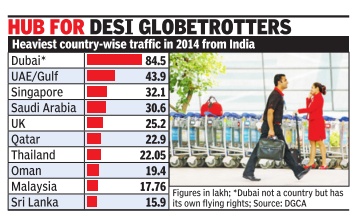
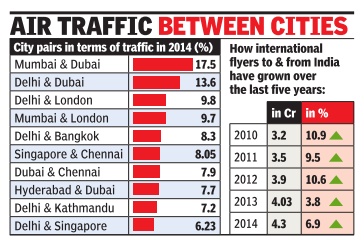
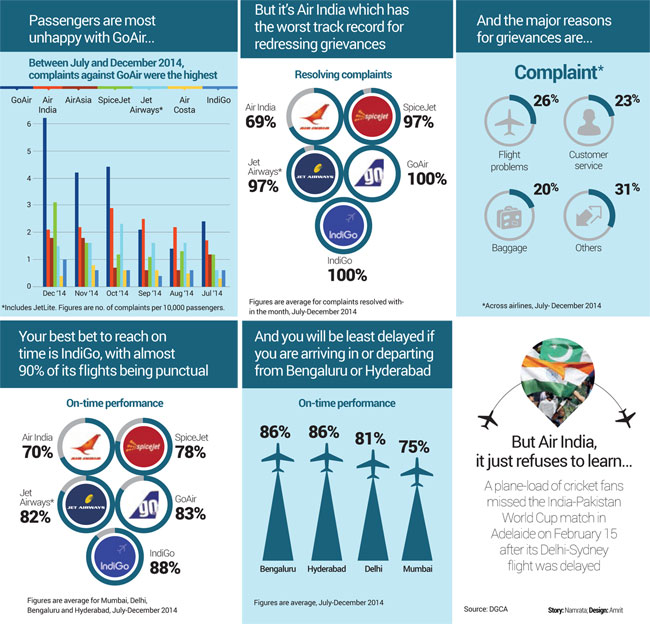
Feb 09 2015
Saurabh Sinha
Mumbai-Dubai busiest route in 2014
Delhi-Dubai Second With 13.6L Flyers
The Mumbai-Dubai sector was the busiest international city pair for travel to and from India last year.With as many as 17.5 lakh people flying between these two cities, closely followed by 13.6 lakh between Delhi and Dubai, the Emirate emerged as the destination most frequented by Indians . Dubai saw a whopping 84.5 lakh people flying to and from India last year, way ahead of the second spot of almost 44 lakh occupied by the rest of UAE -of which it too is a part. London, Bangkok, Singapore and Kathmandu were the other major destinations or transit points for Indian globetrotters last year.
India is an important market for all airlines as interna tional travel has been constantly growing in the past few years. Forget metros, even small towns are generating huge volumes of traffic.For instance, 4.5 lakh people flew between Sharjah and Kochi last year. Thiruvananthapuram and Dubai saw 4.7 lakh people flying between them last year. Pune, Varanasi and Amritsar also saw substantial numbers flying to overseas destinations.
While domestic air travel has seen its share of ups and downs in the past seven years, international air travel has been growing at almost 10%. The next round of growth is expected from small towns. The aviation ministry is allowing new airlines to take shape and is focussing on promoting regional connectivity . It is also planning to make it easier for new airlines to fly abroad.
With these moves, it hopes to counter the dominance of foreign, especially Gulf, carriers.
Dubai's dominance comes from the fact that its airline, Emirates, rules Indian skies and is the third largest carrier in India in terms of international market share.
All Indian carriers that fly abroad -Jet Airways, Air India, IndiGo and SpiceJet -also fly to Dubai. While they offer only point-to-point connectivity between India and Dubai, Emirates offers connectivity to rest of the world for Indian flyers from its hub, making it a virtual Pied Piper for Indian travellers. “Star Alliance accepted Air India into its fold mainly to counter the onslaught of Gulf carriers. Emirates is already known as the de facto national airline of India. Abu Dhabibased Etihad's tie-up with Jet Airways means that Jet will feed that hub from 23 cities in India. Together, Gulf carriers pose the biggest challenge not only for Indian carriers but also other airlines that fly into India,“ said an airline official.
With Jet going the Gulf way , Indian aviation has pinned its hopes on AI weaning away long-haul traffic from them with its new-found Star Alliance membership and the joint venture between Tatas and Singapore Airlines, Vistara.
“IndiGo, SpiceJet and GoAir, when it starts flying abroad, will go only to nearby international destinations.Vistara has the capability to quickly mount long haul flights if the rule for Indian carriers to fly abroad is relaxed,“ said an airline official.
2007-17

the fastest growing routes, 2007-17
From: February 24, 2018: The Times of India
See graphic:
Busiest air traffic routes- 2007-17; the fastest growing routes, 2007-17
2017
Manju V, Mum-Delhi world’s 3rd-busiest air route, January 11, 2018: The Times of India
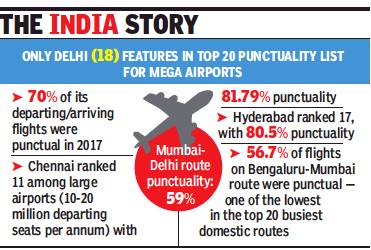
From: Manju V, Mum-Delhi world’s 3rd-busiest air route, January 11, 2018: The Times of India
With 130 flights daily between India’s political capital and the commercial capital, Mumbai-New Delhi was the third-busiest domestic air route in the world in 2017.
A total of 47,462 scheduled flights were operated between the two airports in 2017, next only to South Korea’s Seoul Gimpo-Jeju route (64,991 flights) and Australia’s Melbourne-Sydney (54,519), according to data released by the United Kingdom’s OAG Aviation Worldwide, an air travel intelligence firm.
The ranking is based on the number of total flights operated between two domestic airports and not two cities. Unlike megacities such as New York and London, Mumbai and Delhi have only one major airport each, so all their air traffic is routed from these two airports.
While Bengaluru-Delhi was the 11th-busiest route in the world with 29,427 flights between two airports last year, Bengaluru-Mumbai was 16th, with 23,857 flights.
4 out of 5 busiest air routes in Asia-Pacific
In fact, four out of the top five busiest air routes (both international and domestic together) in the world is in the Asia-Pacific region, with Brazil’s Rio De Janeiro-Sao Paulo (5) being the only outsider.
Among international routes also, all the top five routes were within Asia and only two non-Asian routes—New York La Guardia-Toronto (6) and Dublin-London Heathrow (9) — in the top 10. Hong Kong-Taipei was the busiest international route in the world last year. If both domestic and international routes are listed together, then Hong Kong-Taipei would be the 11th busiest route in the world.
When it comes to punctuality on the 20 busiest domestic routes, Japan emerges on the top with Tokyo Haneda-Osaka route (17th busiest, 21,900 flights) seeing 90.40 % of flights departing and landing within 15 minutes of their scheduled time. Jeju-Seoul had an average on-time performance (OTP) of 74.06 %. In comparison, the Mumbai-Delhi route recorded an OTP of 59.14% — among the worst of 20 busiest air routes. According to OAG, a flight is considered to be on time if it arrives/departs within 14 minutes and 59 seconds of its scheduled time.
A senior A320 commander, requesting anonymity, said: “If the other airports that are as busy or busier than Mumbai and Delhi can manage better punctuality, why can’t we?’’
2017-18: India’s place in the world’s busiest routes
Manju V, Air traffic via India feeds busiest int’l routes, May 6, 2018: The Times of India
Singapore-KL Route Tops With Over 30k One-Hr Flights
The busiest international route in terms of flight volume currently is the one that connects Singapore to Kuala Lumpur, with over 30,500 one-hour-long flights operated to and fro last year.
The three-hour trip linking Mumbai to Dubai may be the busiest route out of India, but is not among the Top 20 busiest in the world on flight volume.
However, Indian airports still play a supportive role in shaping the rankings—for transit passengers on the Singapore-Kuala Lumpur route, Delhi and Tiruchirappalli in Tamil Nadu rate as the fourth and fifth most popular destinations respectively.
A total of four million passengers flew to and fro between Kuala Lumpur and Singapore in the 12 months from February 2017 to March 2018, according to statistics released on Friday by OAG Aviation Worldwide, an air travel intelligence firm based in the United Kingdom.
Of the 2 million who would have flown from Singapore to Kuala Lumpur, about 40,000 were booked to fly on the Singapore-Kuala Lumpur-Delhi route on Malindo Airways, while 34,000 were booked on a Singapore-Kuala Lumpur-Tiruchirappalli flight operated by Scoot.
Similarly, Jakarta-Singapore was ranked third busiest with 27,300 flights operated to and fro last year carrying 4.6 million passengers. Of 2.3 million who flew from Jakarta to Singapore, about 27,300 had booked a Jakarta-Singapore-Mumbai flight on Singapore Airlines.
The other popular route for passengers from India is the Hong Kong-Shanghai Pudong route, which is the fourth most busiest in the world in terms of both quantum of flights (21,800) and passenger volumes (3.8 million). On the Shanghai Pudong-Hong Kong flights, 34,400 passengers were booked on the Shanghai-Hong Kong-Mumbai Cathay Pacific flight last year.
Among the other Top 20 busiest international routes fed by traffic from India was the Jakarta-Kuala Lumpur route (ranked fifth). About 1.3 million flew Jakarta-Kuala Lumpur last year, of which 22,000 passengers had onward connections to Delhi onboard Malaysia Airlines.
The Kuwait-Dubai route (ranked ninth on flight volume) was also a popular one for Mumbai-bound passengers residing in Kuwait. Among the 1.3 million passengers who had boarded the flight in 12 months, 37,000 were bound for Mumbai onboard Emirates. But on the Dubai-Kuwait route, of the total 1.3 million annual passengers, only 6,000 flyers had onward connections to Mumbai.
“Unsurprisingly, 14 of the Top 20 routes operate to, from or within Asia and are routes which connect Hong Kong, Singapore, Seoul and Osaka to other parts of Asia feature strongly. All of the Top 7 routes are routes within Asia, demonstrating the intensity of travel between key hub airports and cities,’’ said the OAG report.
It added, “Outside Asia, there are five short haul routes with high density of scheduled air service. These are New York LaGuardia-Toronto, Dubai-Kuwait, Dublin–London-Heathrow, Amsterdam-London-Heathrow and Chicago-Toronto.”
2018: Mumbai-Delhi world’s 3rd, Bangalore-Delhi 19th busiest
Mumbai-Delhi remained the world’s third-busiest domestic route in 2018 with 45,188 flights operated by six airlines during the year, averaging almost 124 flights daily. UK-based air consultancy firm OAG on Tuesday released the “busiest routes 2019” report, which featured Bangalore-Delhi as the 19th busiest domestic route . TNN/ The Times of India
2020, Aug 21: Tier-II cities on busy aviation map
Manju V, August 17, 2021: The Times of India

From: Manju V, August 17, 2021: The Times of India
Unlike other metros, Mumbai with its congested single-runway airport offered a rather poor choice of direct flights to several Tier-II cities, pre-pandemic. With new work, travel and leisure trends in the past one year, though, flights to non-metros have become increasingly prominent on the city airport’s radar.
Till July this year, 64% of the passengers who passed through Mumbai airport were those travelling to or returning from a non-metro on a direct flight, said a Mumbai International Airport Ltd (MIAL) spokesperson. After the lull in domestic travel brought on by the Covid-19 second wave in summer, the nonmetro routes are back this month with the launch of four weekly direct flights from Mumbai to Bareilly and the relaunch of 18 weekly direct flights to Tier-IIs such as Ajmer, Porbandar, Tirupati and Vishakhapatnam. Last month, Gwalior had joined Mumbai airport’s direct flight list.
“Between January and July, Mumbai airport handled over 75 lakh domestic passengers, of whom over 48 lakh were flying to or from about 60 non-metros,” said a Mumbai International Airport ltd (MIAL) spokesperson. These included leisure travellers and passengers flying between home and their work city as is evident from the top three non-metro destinations out of Mumbai during this period — Goa, Ahmedabad and Varanasi — that is. But metro airports were the traffic kingpins with Delhi and Bengaluru among the overall top three domestic destinations out of Mumbai. Kapil Kaul of Centre for Asia Pacific Aviation, an aviation consultancy firm said, “Non-metro to metro routes are increasingly seeing more flight deployment during COVID. Prior to Covid, flight operations from Mumbai, especially to non-metros were significantly constrained due to capacity shortage.”
The spike in demand for flights to non-metros began last year after domestic flights were restarted on May 25 following a twomonth ban. In the new normal, business travel was negligible, metro-to-metro travel was down as flights packed migrants fleeing cities for their homes in tier-IIs realigned domestic air traffic pattern. According to Airports Authority of India statistics, the Tier-II destinations recovered faster, they registered a lower drop in passenger traffic as compared to the metros by the end of last fiscal. For instance, while Mumbai airport saw a 71% drop in passenger traffic in 2020-21 as compared to the previous year, the corresponding drop was 57% for Lucknow, 51% for Ranchi and Raipur, 48% for Varanasi, 40% for Patna, 25% for Gorakhpur, 13% for Pathankot, and so on. Kaul said, “We will see more operations to non-metros as Mumbai airport now has capacity available and airlines like IndiGo are keen to broaden their network.” Prior to Covid, the airport’s lone runway handled about 950 flights in 24 hours. Today, it handles an average of 300 flights, less than a third of its capacity.
A low-cost airline official said, “Regional connectivity scheme never really took off in Mumbai due to airport slot constraints. People bound for non-metros had to transit via Delhi, Bangalore, Kolkata etc with no direct flights to smaller cities. But Covid has changed that, for now at least.”
Air routes, the most profitable
2019, June

From: July 27, 2019: The Times of India
See graphic, ‘ The most profitable air routes in India in 2019, June ’
Air shows: Bangalore
1911
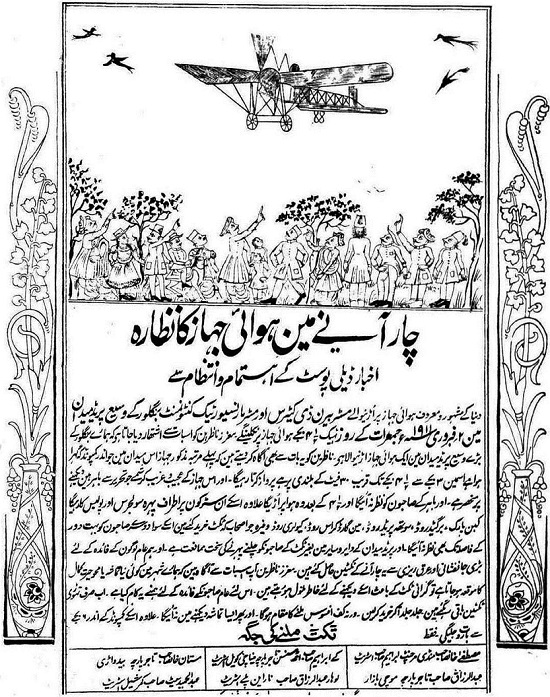
The headline reads Chaar aaney mein hawai jahaz ka nazaara (Four annas [Re.0.25] to see an aeroplane) / Akhbar Daily Post kay ehtemaam aur intezaam say (Organised by the newspaper Daily Post)
Chethan Kumar | TNN | Bengaluru had its first date with air show a century ago, Feb 20, 2017
Bengaluru had its first date with an air show in 1911.
In 1911, Jules Wyck and Belgian adventurer Baron Pierre De Caters were the two pilots who brought their aircraft to Bengaluru
BENGALURU: As the curtains were drawn on the 11th edition of Aero India on Saturday, thousands who thronged the Yelahanka Air Force Station need to know that they are not the first patrons of such a show. In fact, they are not even the first generation.
Bengaluru, India's aviation capital, had its first date with an air show 106 years ago. February 3, 1911. Cricket hadn't become the religion it is today in India. The Chinnaswamy Stadium was a barren land, and parts of Bengaluru were still a functional cantonment.
While people from districts neighbouring Bengaluru had made their way back then to catch what the organizers had called a "miracle in the skies," Bengaluru's quest for the flying machines remained intact in 2017 with at least three lakh people reported to have visited the aero show.
In 1911, Jules Wyck and Belgian adventurer Baron Pierre De Caters were the two pilots who brought their aircraft to Bengaluru, for a show that garnered a huge response. "But police had been prepared to handle the crowd here, after things had gotten slightly out of hand in Kolkata," historian Vemagal Somashekar said.
If the elaborate preparations of the organizers a century ago are any indication then it only shows that a lacklustre event, like the 2017 edition of Aero India — just 53 aircraft on display and four aerobatic display teams — may fail to garner similar response in the coming years.
The fact that organizers did not reveal the right number of aircraft at Aero India 2017 is an indication that even they know it. When TOI enquired about the details of the show and the preparations in the run-up to the show, Mayaskar Deo Singh, director, Defence Exhibition Organisation, the nodal government agency organizing the show said: "An official release with final numbers on participation and other details will be issued so that there is no confusion."
The official release days before the show had claimed that the number of aircraft participating would be 72, as many as the 2015 show, rated much better, had seen. Answering a specific question, defence minister Manohar Parrikar, however, had said on February 14: "There are 53 aircraft participating..."
Also, there are ways to watch the show for free, hundreds of citizens who stood with their cameras on terraces, the highway, some even got hospitality at villages around the air base.
But organizers in 1911 had figured out a plan for such free viewers. A poster in Urdu, issued by merchants and businessmen from the Baidwadi (present day Shiva jinagar) area, reveals that the organizers, who had learnt that people would not buy tickets as they thought planes could be spotted even otherwise, had organized the show in such a way that only those with tickets (worth 25 paise each) had a one-hour exclusive.
"...Between 3.30pm and 4.30pm the planes will fly at a height of just 30 metre which only the ticket holders can see. For a few minutes after 4.30pm, the planes will fly a little higher," reads a translation of the poster documented by the state archives department.
Mustafa Khan (mandi merchants, Ibrahim Sahib Street); Abdul Razak (businessman, Modi Road); Ibrahim Sahib (Meenakshi Kovil Street), Abdul Razak Sahib (steel merchant, Narayan Pillai Street) and Mastan Khan from Baidwadi (present day Shiva jinagar) were the men who had signed off on the poster —they are an indication of how Bengaluru had a good trade set-up.
While TOI got a look at the poster, permission to take a photograph was denied. The poster, which has been sourced from fly.historicwings.com, further reveals as Somashekar had pointed out.
Police had been ordered to patrol major roads leading to the venue such as South Parade Road (now MG Road), Brigade Road and Church Street and even in Cubbon Park.
Air traffic control (ATC)
2018: mobile ATC towers
Jharkhand’s steel city Bokaro has become the first airport to get a mobile air traffic control (ATC) tower at its airport. The state-run Airports Authority of India (AAI) has acquired eight trailer-mounted towers at a cost of Rs 64.6 crore from a Slovak company for being used at small airports for regional connectivity scheme (RCS) flights.
“With the Ude Desh Ka Aam Nagrik (UDAN or the subsidised regional flying scheme where fares are capped at Rs 2,500 per hour of flying) we will see a number of small airports getting one or two flights a day. In the past also we had used mobile ATC towers but now we are doing it in a systematic manner given the demand for RCS flights.,” said AAI chairman Guruprasad Mohapatra.
The mobile towers have been purchased from MSM Martin Company Slovakia, Slovak Republic. The first eight will be used in Bilaspur, Ambikapur, Jagdalpur, Jeypore, Utkela, Vellore, Bokaro and Mithapur (Gujarat).
An AAI official said: “Mobile ATC towers have been developed keeping in mind Indian ATC requirements. Technically, these mobile towers are top class and allow operations in any airport in India.
Alcohol on domestic flights
Banned in the 1990s
Saurabh Sinha, No wine on flight, courtesy unruly flyer, Mar 29, 2017: The Times of India
In the wake of the violent MP issue, everyone abhors unruly passengers now for being a big risk to flight safety , co-passengers and crew members.This dislike will go up several notches when you realise that you are denied a harmless glass of wine or beer on domestic flights thanks to one such disruptive flyer.
The government had way back in early 1990s suspended the flying licence of Damania Airways for about 10 days after two passengers got into a brawl (one of them got inebriated) after being served liquor on a MumbaiGoa flight, said an industry old-timer. Following this episode, the government banned serving of alcoholic drinks on domestic flights.
Parvez Damania, the promoter of Damania Airways which flew from 1993 to 1997, says grounding of his airline for a drunken brawl was “politically motivated“ and it took help from several quarters to get it revoked. Damania was among the first airlines in India to serve liquor on domestic flights. After Damania, Vijay Mallya made a strong pitch for allowing at least beer on domestic flights when Kingfisher started flying in 2005. But by then the fear of people getting drunk on `short' domestic flights had gripped the authorities which continues even now and the permission has not been given again.
“A Delhi-Kochi flight is as long as Delhi-Dubai and Delhi-Port Blair nonstop is longer. But one can have beer while flying to Dubai but not on same duration or longer flights in India. This is thanks to a disruptive passenger's act almost 24 years back,“ said the industry old-timer.
Annual growth/ decline in traffic
1970-2017: no. of fliers in India, China, major countries
July 27, 2019: The Times of India

From: July 27, 2019: The Times of India
See graphic:
Air passengers carried, in India, China and other major countries, 1970-2017
How jet engine changed international travel
Before regular civilian jet flights started between Europe and America in 1958, travellers crossed the ocean in ships. But early passenger jets like the British de Havilland Comet and the American Boeing 707 quickly dented sea traffic.
In 1967, Cunard — a British–American passenger line that carried most of the trans-Atlantic passengers — withdrew its biggest ships, Queen Mary and Queen Elizabeth. Today, jet planes are the only practical way to travel long-distance
1991-2015
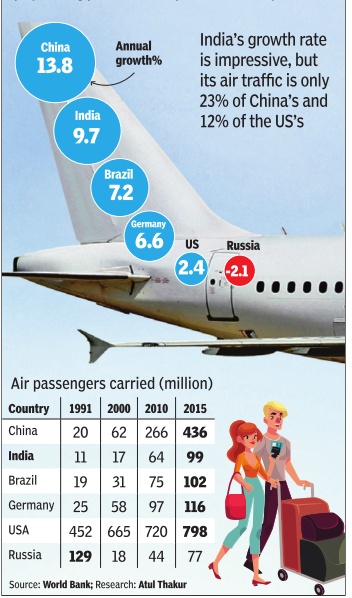
The Times of India, Jan 20, 2017
See graphic:
Air passengers carried, India and the world, 1991-2015
2014/ No. of fliers rises 10%
Jan 20 2015
Give low fares and Indians will fly like never before. The constant flash sales by SpiceJet last year, which forced other carriers to follow suit, has led to a record 6.7 crore people flying within India in 2014. In December, 64.4 lakh flyers took off within the country, possibly the highest ever number of people flew in a month.
But SpiceJet, which started the fare war, saw itself running out of cash by November, which led to aircraft leasors repossessing many of its Boeing 737 aircraft. Since November, the airline saw its market share fall. In December 2014, its market share was 10.4%, down from 20.4% in July . The low cost carrier is now headed for a change of ownership with co-founder Ajay Singh back in the cockpit.
1995-2019
Dec 12, 2021: The Times of India

From: Dec 12, 2021: The Times of India
Until the late 1980s, civil aviation in India was completely under government control. Private air-taxis were allowed in 1986, followed by the Open Air Policy-1990 and the Air Corporations (Transfer of Undertaking and Repeal) Act of 1994, which opened civil aviation to the private sector. Aided by the growth of other industries in the post-liberalisation era, India’s civil aviation sector has soared since the 1990s 7,000 flights a day Covid has hurt airlines across the world, but before it India was in a phase of rapid growth. The number of flights increased from under half a million in 1995 to 2. 6 million in 2019-20, which translates to about 7,000 daily flights
2014: No. of passengers
The Times of India, Sep 06 2015
As air travel becomes easier and cheaper, more and more travellers are choosing to fly. Flight departure data collected by the World Bank shows that the US recorded over 95 lakh flights leaving from its airports in 2014, followed by China with 33 lakh. In comparison, India clocked only 7.2 lakh
August 2015: domestic fliers
The Times of India, Sep 23 2015
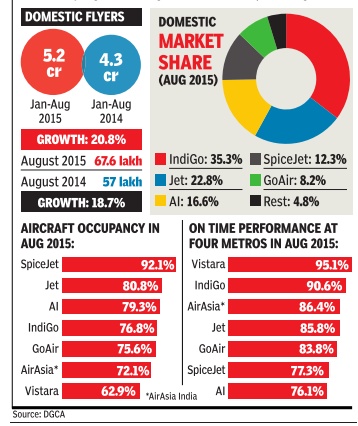
Low fares have made Indian skies a crowded place once again.Deep-discount carrier SpiceJet has been enjoying maximum aircraft occupancy for five months in a row, while full service Vistara is yet to catch flyers fancy. With low-cost carriers ruling the skies, the time has come for budget terminals in India -without sky-high user charges -to meet next phase of growth
2015: India, fastest growing air travel market
The Times of India, Oct 02 2015
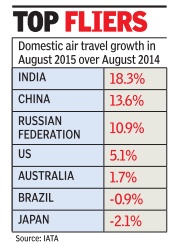
India fastest growing air travel mkt globally: IATA
Thanks to low fares and increase in capacity with launch of new airlines, India is now witnessing the highest growth in domestic air traffic globally.
The International Air Transport Association (IATA) said India's domestic passenger traffic demand grew the fastest among seven major aviation markets of the world -Australia, Brazil, China, Japan, Russian Federation and the US.
“India's domestic demand surged 18.3% in August (2015) compared to a year ago, largely reflecting increases in service frequencies and economic strength,“ IATA said. India's growth was followed by China at 13.6% and the Russian Federation at 10.9%.
India's domestic traffic ro se 28% in July , 16.3% in June; 18.2% in May , 20.7% in April and 17.9% in March 2015. August's 18.3% growth, though lower than the growth registered in July, was the fastest globally for that month. India's domestic capacity in the month under review rose 8.4% compa red to August 2014.
“August figures show continuation of the trend of strong demand for air travel, despite some softening in global economic growth, particularly in emerging markets,“ said Tony Tyler, IATA's DG and CEO.
2015: 20% rise in domestic air travel
[[File: 2015, domestic flights in India, number of flyers, airlines’ market share, load factor and on-time performance.jpg|2015: Domestic flights in India: number of flyers, airlines’ market share, load factor and on-time performance; Graphic courtesy: The Times of India, January 19, 2016
20% jump in domestic air travel in 2015
Domestic air travel rose by 20.3% in 2015 over the previous year, registering one of the highest growth rates in the past decade. A record 8.1 crore domestic flyers took to the skies last year, with December logging the highest-ever monthly traffic of over 77 lakh. Low oil prices, which led to airlines offering cheap air fares, lured travellers back. To top low fares, airlines added capacity and frequencies.
Mid-2015- Feb 2017: fastest growing domestic market
Indian air mkt grows fastest for 22 months, March 8, 2017: The Times of India
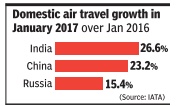
India has been the world's fastest growing domestic air market for 22 months in a row, the International Air Transport Association (IATA) said on Tuesday.This means in last 22 months, India has seen the highest growth in domestic air travel over the same month in previous year. “India led all domestic markets in year-to-year growth for the 22nd month in a row. (Globally) Domestic air travel climbed 9.9% in January year-on-year. All markets except Brazil showed growth, paced by double-digit increases in China, India and Russia,“ IATA said.
2016: 25% rise in domestic air travel
Record 10cr flew within India in 2016, Jan 18, 2017: The Times of India
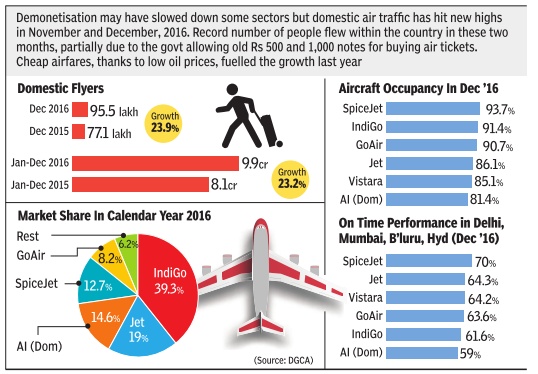
Cheap air fares in 2016, except during peak travel seasons, thanks to low oil prices and stiff competition, led to a record number of almost 10 crore people flying within the country , up nearly 25% from the previous high of 8.1 crore in 2015.
The post demonetisation period of November 9 to December 31 alone saw over 1.5 crore domestic flyers. Low oil prices made India the world's fastest growing aviation market, with domestic traffic growing at over 20% constantly.
2016: International travel, a rise of 10.4%
Saurabh Sinha, Notebandi fails to impact int'l travel, Feb 22, 2017: The Times of India
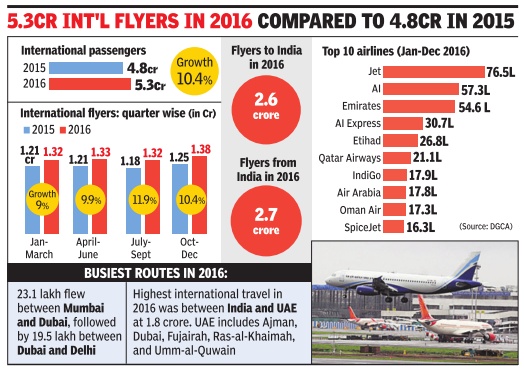
It's official now.Demonetisation, announced by PM Narendra Modi on November 8, did not have any impact on international trips to and from India in the October-December, 2016, quarter.
These three winter months -which happen to be the peak inbound months for travel to India -saw the maximum international travel in all the four quarters last year. Thanks to a robust inflow of 71.7 lakh international flyers, the overall foreign travel (arrivals plus departures) in the October-December quarter, 2016, was 1.38 crore -up 10.4% from 1.25 crore in the same quarter previous year (2015).
“People who had to travel, travelled. The numbers show that there were no cancella tions due to the November 8 announcement,“ said Manoj Chacko, CEO business travel at SOTC. Karan Anand of travel major Cox & Kings also said that people did not change their travel planes due to de monetisation. “It (banning of old notes of Rs 500 and Rs 1,000) has not impacted the big organised travel industry players.We have constantly seen buoyancy in outbound travel quarter over quarter,“ Anand said. India saw 5.3 crore international travellers in 2016, up 10.4% from 4.8 crore recorded in the previous year. TOI had on January 25 estimated international travel to be at 5.2 crore last year. Domestic air travel had grown 23.2% in 2016 over 2015 with almost 10 crore people taking to the skies last year.Demonetisation has so far neither impacted domestic, nor international flying.
2016 saw the JetEtihad combine carrying over a crore passengers in and out of India, with the Air India-AI Express combine behind at 88 lakh. Emirates remained the single largest foreign airline with a traffic of 54.6 lakh. It is desperately seeking more flying rights to India.
The growth in international travel came as low oil prices helped airlines, both international and domestic, to offer low fares that led to Indians travelling overseas like never before. Travel portal Yatra COO Sharat Dhall had recently told TOI: “International airfares in 2016 were significantly lower than those in the previous year and airlines offered amazing deals. Apart from this, visitors had access to budget and shared accommodation. As a result, we saw a significant jump in international bookings last year.“
2016> 2017: Rapid growth, especially in Delhi
April 22, 2018: The Times of India

From: April 22, 2018: The Times of India
See graphic:
5 Indian airports, notably Delhi, were among the word’s 20 airports with the fastest growth in passenger traffic
DELHI AIRPORT GROWING TWICE AS FAST AS SHANGHAI
India’s massive airline market potential is rapidly being realised with more people choosing the conveniences and reach of air travel over rail and road. As reported in the Airports Council International air traffic rankings of 1,202 airports, demand doesn’t look like slowing down any time soon
March 2017 vs. March 2016
The Times of India, April 21, 2017
See graphic.
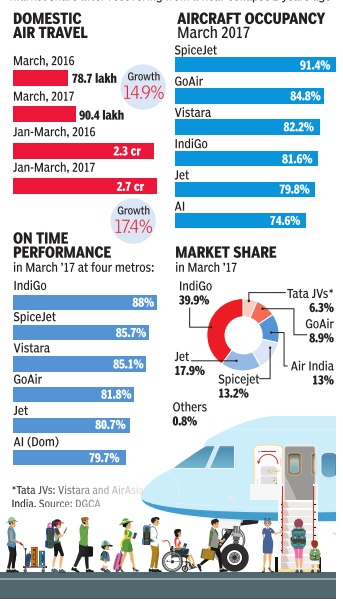
The 20% plus growth in domestic air travel has taken a break in the lean travel month of March. The month saw IndiGo return to the top of on-time-performance charts after several quarters.SpiceJet pipped Air India to become the third largest airline in market share after recovering from a near collapse in 2015.
2017: India world’s no.3/ domestic; no.4/ international

Equals UK In Domestic & Int'l Flyer Nos
Propelled by the tail wind generated by increasing domestic air travel demand, the Indian aviation industry continues to soar to new heights. The world's fastestgrowing air travel market for several months in a row has added another feather on its cap by being the third-largest domestic aviation market globally with more people flying within the country last year than Japan, which has been pushed to number four spot.
Calendar year 2016 saw 10 crore domestic flyers in India, more than the 9.7 crore in Japan, according to the Centre for Asia Pacific Aviation (CAPA). “In 2015, India was at number four in domestic air travel and now it is at number three. Japan was number three in 2015,“ said Kapil Kaul, India head of CAPA.
“On the internationalcum-domestic air travel front, India saw a combined traffic similar to the UK in 2016 and they are both at number four spot now. UK was ahead of India on this front in 2015. Given the way our air traffic is growing, India is all set to overtake UK this year,“ said Kaul. This data emerges from a report CAPA has prepared for the aviation ministry . According to the International Air Transport Association (IATA), India has overtaken Japan on domestic air travel front as the country has been the world's fastest growing in-country market for 22 months in a row .
This growth, however, has left Indian airports at least the big ones choking. While slots for new flights at metro airports like Delhi and Mumbai are very hard to get, hover ing of flights is a regular occurance again due to air traffic congestion. Given the massive growth, Indian carriers have ordered hundreds of planes but no one knows where they will even be parked.
The government has said it will add aviation infrastructure. Navi Mumbai may get the hugely-delayed airport in a few years and Delhi could also expect another airport in NCR soon with a BJP government both at the Centre and in Lucknow.
“Our expectation is that we would have at least two to three greenfield (new) airports in UP. We are already working with the state government to determine where they would come. There is tremendous interest in a new greenfield airport in western UP and we will like to expedite it with the state government. The greenfield airport in western UP will definitely serve two purposes enable world class air connectivity in the area and add more flight connectivity options for the NCR,“ aviation minister Jayant Sinha said.
2017/ 1 crore fliers in a month (domestic passenger traffic)
1cr in a month: New high in home traffic, June 20, 2017: The Times of India
Indians are travelling like never before this summer holiday season. May 2017 has, for the first time, seen one crore passengers flying within the country in a month. Summer holidays begin around mid-May , which is when the surge began. According to DGCA data, May 2017 registered a 17.4% increase in domestic flyers over 2016, which recorded 86.7 lakh domestic flyers. The surge has come despite the increase in airfares since early this year on account of rising crude oil prices.
Low-cost carriers rule the skies, with IndiGo, SpiceJet, GoAir and others accounting for almost two-thirds of all domestic flyers. IndiGo alone has 41.2% of the market share for domestic air travel, followed by Jet (17.6%) at a very distant second. “The book ings for June are also very robust. The lean season will begin from next month, but will be fortunately short this year as the festive season is starting in September,“ said an airline official. The January to May 2017 period has seen 4.6 crore domestic flyers, up 17.6% from last year.
2017, Jan-Nov: Domestic flyers cross 10-crore
Domestic flyers cross 10-crore mark in Jan-Nov ’17, December 20, 2017: The Times of India
India’s air traffic is booming, amid a crippling airport infrastructure crunch at its main aviation hubs of Delhi and Mumbai. This year in the 11 months from January to November, 10.6 crore people flew within the country — more than the 9.9 crore domestic flyers in January-December, 2016. This is the first time domestic flyer tally in a year has crossed the 10-crore mark in India and at the rate traffic is growing, 2017 is set to end with a total tally of at least 11.5 crore people flying within the country.
The record travel is also due to the steep rise in air travel during festive and holiday months. November 2017 saw one-crore-and-five-lakh domestic flyers, up 17% from 89.7
lakh in the same month last year. This is the third time this year when monthly domestic air travel crossed the croremark after October and May.
While the growth in air travel has come on the back of low fares offered by airlines, airport infrastructure has failed to keep pace with this jump in travel. Mumbai airport is saturated, with no new slots to offer as it has no place to expand. Delhi airport — with ample land bank — did not see any expansion in its terminal or runway capacity as traffic grew exponentially and is choked now.
“On time performance (OTP) is suffering due to infra crunch. Hovering for over half an hour is routine at Mumbai. Delhi also has poor on time performance due to congestion,” said a senior pilot. The Directorate General of Civil Aviation (DGCA) data itself shows the low OTP of airlines. In the prefog November, 2017, OTP at four metro airports (Bangalore, Delhi, Hyderabad and Mumbai) was: Jet at 54.1%; GoAir at 65.6%; Vistara at 67.6%; Air India (domestic) at 69.3%; IndiGo at 80.4% and SpiceJet at 81.9%.
2017: 11.7 crore domestic flyers
At 11.7 crore, domestic flyers highest ever in 2017, January 24, 2018: The Times of India

From: At 11.7 crore, domestic flyers highest ever in 2017, January 24, 2018: The Times of India
See graphic:
Domestic flyers, 2016-17 and domestic market share in 2017
India crossed the 10-crore domestic flyers in a year mark for the first time ever in 2017 with 11.7 crore flying within the country, up 17.3% from 9.9 crore in 2016.
Sharat Dhal, COO at travel portal Yatra, said: “2017 ended on a buoyant note for the airline industry with a strong passenger growth in December. Despite localized issues such as bad weather conditions, poor visibility and excessive fog in various parts of the country, the domestic passenger market registered a strong growth of 17.3% in December over last year. We expect that passenger traffic will continue on the same growth path in January.”
However, the aviation industry is worried over failure of airport infrastructure to cope up with the growth, due to which most big airports — especially Mumbai and Delhi — are bursting at times. They point out that low crude prices in past three-to-four years enabled them to offer low fares, which led to a massive jump in number of flyers.
2018, Apr-May: high domestic, international traffic
Saurabh Sinha, July 6, 2018: The Times of India

From: Saurabh Sinha, July 6, 2018: The Times of India
The just-concluded summer holiday season saw Indians flying like never before both within the country as well as to foreign shores. According to Airports Authority of India (AAI), the two months of April and May saw 9.4 lakh flyers (domestic and international combined) every day — up 17.7% from same period last year.
And thanks to aggressive fleet augmentation by Indian carriers, domestic air travel grew by 20.3% in these two months while international growth was at 8.2%, said AAI. The six JV airports at the four metros, Kochi and Nagpur saw more passenger traffic than all the 109 others run mainly by AAI and a few by state governments put together.
“Air traffic has been steadily growing and we are creating the infrastructure to cater to the same. Our aim is to see India as the top aviation market globally,” AAI chairman Guruprasad Mohapatra said.
While the number of flyers is undoubtedly rising, domestic air travel’s rate of growth has started slowing down as increase in fuel prices has forced airlines to hike fares and other charges like excess baggage. “India’s domestic traffic rose 16.6% year-overyear (May 2018 over May 2017), which was down from 25.7% in April. Passenger volumes in India have fallen back in seasonally-adjusted terms in recent months alongside some mixed signals on the economic front. Notwithstanding this, May was India’s 45th consecutive month of double-digit annual growth,” International Air Transport Association (IATA) said on Thursday.
Despite slowing down, IATA said India was the fastest growing domestic air travel market globally in May 2018 with 16.6% growth over same month last year. India was followed by China at 11.9%, with Russia, US and Brazil at 8.6%, 5.5% and 4.1%, respectively. Not surprisingly, global agencies remain bullish on India. “Demand continues to be supported by strong growth in the number of airport connections within the country: some 22% more airport-pairs are scheduled to operate in 2018 compared to last year,” IATA added.
While fares are rising, Indian carriers say the growth this summer could have been more had expansion of Indian airports kept pace with air traffic’s explosive growth here in last few years. Airlines are not getting slots at key airports like Delhi and Mumbai and growth centres like Patna. The rise in flyer numbers is mainly due to planes going fuller apart from few flight additions wherever it is possible to get a few slots.
Apart from crippling slot constraints, the growth in international traffic was below potential as India has not increased flying rights of major travel magnets nearby like UAE, Singapore and Turkey despite repeated requests from these countries to do so. This is being done to protect the interest of Indian carriers and the aviation ministry has clearly told the hub airports in these countries to give decent slots to our carriers for adding flights before their bilateral would be enhanced.
2018> 19: No. of passengers falls in Delhi, Mumbai
Saurabh Sinha, January 10, 2020: The Times of India

From: Saurabh Sinha, January 10, 2020: The Times of India
NEW DELHI: For the first time since 2008, India's busiest airports - Delhi and Mumbai - have seen a year-on-year dip in passengers in 2019 compared with 2018. While Indira Gandhi International (IGI) Airport saw fewer domestic passengers, Chhatrapati Shiva ji Maharaj International Airport (CSMIA) registered a fall in both domestic and international carriage.
Amid an overall slowing economy, the biggest reason for decline was Jet Airways' collapse last April. IndiGo and GoAir's Pratt & Whitney (PW) engine troubles for their Airbus A320 Neos and SpiceJet's grounded Boeing 737 Max too contributed to fewer flyers last year. Closure of Pakistan airspace for 138 days led to airlines cancelling flights to and from Delhi and Mumbai for varying durations. As a result, Delhi and Mumbai were deprived of the records they were hoping to achieve in 2019.
IGI, India's busiest airport, was just 2 lakh short of the magic 7-crore annual passenger (domestic-cum-international) mark in 2018 when it registered 6.98 crore flyers. DIAL's provisional data for 2019 shows it handled 6.8 crore passengers - down 2.6%.
Delhi airport saw 1.9 crore international flyers in 2019, up 0.6% from 1.8 crore in 2018. Domestic flyers, however, fell 6% from almost 5.2 crore in 2018 to 4.9 crore in 2019. Similarly, CSMIA had ended 2018 two lakh short of the 5-crore (domestic-cum-international) flyer mark at 4.98 crore. But Mumbai International Airport Ltd (MIAL) data for 2019 shows it handled 4.7 crore passengers - down 5.6%.
Mumbai airport saw 3.38 crore domestic flyers in 2019, down 3.4% from 3.5 crore in 2018. And international flyers fell 7% from 1.4 crore in 2018 to 1.3 crore in 2019. The last time domestic air travel had dipped across India, say airline officials, was in 2008 when the global slowdown started but thanks to low cost carriers quickly spreading their wings in India, that issue was overcome from 2009 onwards.
While IGIA and CSMIA were Jet's twin hubs in India and suffered the most from the airline's collapse, India as a whole did not see a fall in number of air travellers. DGCA data for the full year 2019 is awaited. Its January-November data shows the country saw 13.1 crore domestic flyers in 11 months of 2019, up almost 4% from 12.6 crore in the same period of the previous year. DGCA's January-June data shows India saw 3.19 crore international passengers in the first six months of 2019, up 1.2% from 3.15 crore in the first six months of the previous year.
AAI saw a modest 5% growth to 14.8 crore domestic-cum-international passengers in January-November 2019 at its airports (not JV metro ones) over 14.1 crore in the same period of the previous year. However, these are a far cry from the double digit growths seen in past few years. Bengaluru and Hyderabad are yet to share their 2019 passenger numbers.
DIAL said in a statement: "….technical issues in aircraft engines (referring to PW engine trouble of A320 Neos)/newer aircrafts (referring to B737 max) impacted supply side of air traffic. During CY 2019, Indigo, SpiceJet, and GoAir faced issues on grounding of their aircrafts by the regulator due to technical issues leading to cancellation or lower operations impacting air traffic.”
2019: India slips to 4th place in domestic air traffic
Oct 11, 2019: The Times of India
India slips to 4th slot in domestic air traffic
New Delhi:
India, which used to be the world’s fastest growing domestic aviation market globally till not so long back, has now dropped to the fourth spot in that ranking.
International Air Transport Association (IATA) on Thursday came out with global data for air travel this August. According to this, India saw 3.7% more domestic flyers in August 2019 over same months last year — behind 10.1% of China, 6% of Russia and 3.9% of US.
Domestic air travel in India has in recent months started showing signs of recovery from the blow dealt to it by the closure of over 110-aircraft-strong Jet Airways this April. TNN
2019: 3.7% growth
Saurabh Sinha , January 20, 2020: The Times of India
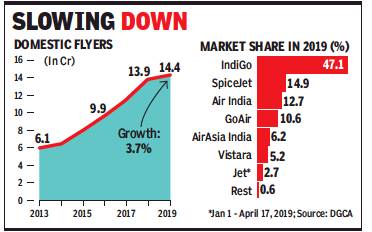
From: Saurabh Sinha , January 20, 2020: The Times of India
NEW DELHI: The double-digit growth of domestic air travel seen in past few years slowed to a mere 3.7% with 14.4 crore people flying within the country in 2019, against 13.9 crore in the year before. The fall in growth, though still in positive territory to be sure, happened due to the collapse of Jet Airways last April that led to a sharp hike in airfares amid an overall economic slowdown.
The year 2018 had seen 18.6% more domestic flyers than 11.7 crore in 2017. And the 2017 figure was 17.3% higher than 9.9 crore of 2016. Still the aviation ministry’s quick grant of Jet’s slots to other airlines after its collapse, with SpiceJet and Vistara taking ex-Jet Boeing 737s, and IndiGo growing at its one-plane-a-week pace, ensured that 2019 over 2018 did not see a fall in domestic air carriage.
A senior official said: “(The 3.7% growth is) a bit disappointing. In 2019, we faced headwinds on account of Jet Airways’ (closure) but 2020 is going to be different and the double digit growth should be back sooner rather than later.”
Jet had shut down in April and this month saw 4.5% less domestic flyers than same month in previous year. After that as Jet’s slots and aircraft were taken by other airlines, November 2019 saw 11.2% more domestic passengers than same month previous year. However, this growth momentum lost pace in December with growth down to 2.5% (December 2019 over December 2018).
The collapse of Jet saw full service airlines’ share in domestic air travel at 20.6% for the whole year with Air India at 12.7%, Vistara at 5.2% and Jet’s 2.7% till its had its last flight on April 17, 2019. Low cost airlines now account for over 80% of domestic air travel (taking AI and Vistara’s combined 17.9% into account). IndiGo at 47.1%, followed by SpiceJet at a very distant 14.9%, remained the market leader by a huge margin.
Baggage allowance
HC: DGCA has no power to fix tariff for excess baggage
Checking-in above 15kg to be costly, August 17, 2017: The Times of India
Delhi High Court Sets Aside DGCA Order Capping Charge At Rs 100 For Each Extra Kilo
Checking-in more than 15kg on domestic flights can now blow a big hole in your pocket.
The Delhi high court set aside a Directorate General of Civil Aviation (DGCA) order that capped excess baggage charge at Rs 100 per kg for each extra kilo between 15kg and 20 kg. Justice Vibhu Bakhru said DGCA had no power to fix such tariff for excess check-in baggage.
While the airlines were earlier free to charge any amount as excess baggage charge beyond 20kg, they can now go back to their old fee of up to Rs 350 per kg beyond 15kg itself. For flyers, it may mean shelling out up to Rs 250 more per kg in the 15-20kg band.
About two years back, all Indian carriers -except Air India -had reduced free check-in baggage allowance for economy class domestic flyers from 20kg to 15kg.They then started charging anywhere between Rs 220 to Rs 350 per kg for each kilo beyond 15kg. After complaints from passengers, the DGCA directed airlines on June 10, 2016 not to charge more than Rs 100 per kg between 15 and 20kg. Beyond 20 kg, they were free to charge any amount. The Federation of Indian Airlines, which has carriers like IndiGo, Jet, GoAir and SpiceJet as members, challenged this order and moved court.
The Directorate General of Civil Aviation circular had come into effect from July 1 last year as the court had not stayed it or deferred the date of implementation after the FIA challenged the move. The court had then clarified that the amount charged by the airlines would be restored if the FIA succeeded in its plea challenging the circular.
FIA, in its plea, argued that DGCA did not have the jurisdiction to fix tariff as this power rested with the airlines and the fares were determined by the market forces. It had said that the DGCA could interfere only when there were specific instances of discriminatory practices and such circulars could not be issued in a general manner.
Currently , all domestic carriers allow free check-in baggage up to 15 kg. Only Air India allows free baggage up to 23 kg.
Bilateral flight agreements
2004-17: with Bangladesh, Nepal, Sri Lanka
September 27, 2018: The Times of India
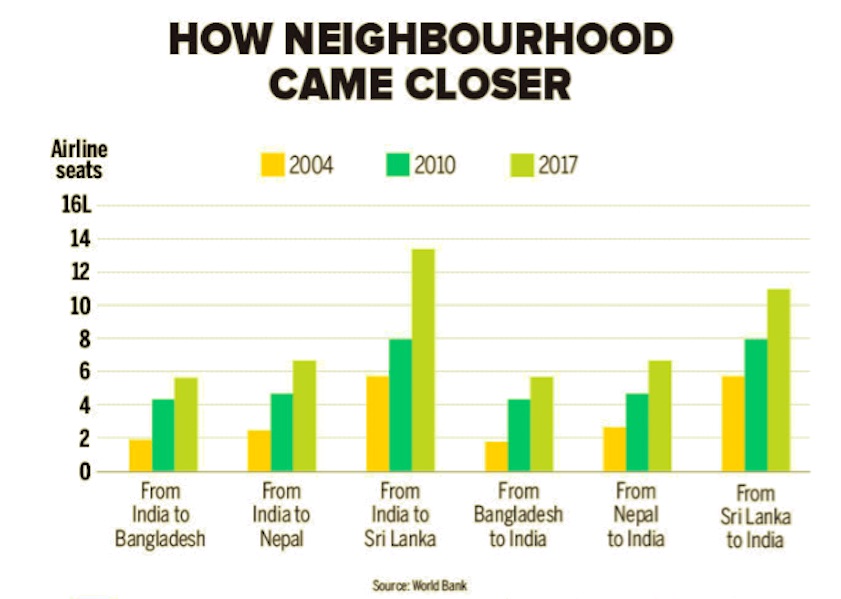
From: September 27, 2018: The Times of India
See graphic:
2004-17- The number of airline seats on flights between Bangladesh, India, Nepal and Sri Lanka
Improvements in bilateral flight agreements have led to opening up of more destinations, providing a big boost to tourism in South Asia particularly between India and Sri Lanka.
Biofuel
2018: SpiceJet turboprop pioneers biofuel in India
Ramarko Sengupta, August 27, 2018: The Times of India
Saurabh Sinha, Trailblazer: Plane flies Doon-Delhi on biofuel, The Times of India
India’s first biofuel-powered flight was successfully tested. The SpiceJet aircraft from Dehradun to Delhi had aviation regulator DGCA (Directorate General of Civil Aviation) officials along with other industry stakeholders on board, to ascertain the feasibility of biofuel-powered flights.
Before we get into the other details, the question on most people’s minds would be -- Does it fly any different? In other words is it any less powerful?
Such a concern is natural, given that many people would draw parallels with how a CNG (Compressed Natural Gas)- powered vehicle does not quite feel or drive the same way a regular petrol or diesel powered one does.
To understand if a biofuel flight is likely to feel any different from a regular jet fuel flight, TOI spoke with a senior pilot at an Indian airline. “Aircraft engines use certain grades of fuel, jet A1 fuel being the most common. This is essentially purified kerosene. With biofuel you can just about get anything -- diesel, petrol, or even jet fuel. As long as the grade is right there should be no power loss,” said the pilot who did not wish to be named, as he’s not authorised to speak with the media.
A SpiceJet turboprop aircraft named Haldi became India’s first plane carrying passengers to operate on biofuel when it flew from Dehradun to Delhi on Monday, raising hopes for low-emission flights less dependent on increasingly expensive jet fuel.
The biofuel, derived from the jatropha plant grown by 500 farmer families in Chhattisgarh, was first tested on a 20-minute flight on Haldi with only crew in Dehradun a day earlier.
After the green fuel performed better than expected, the Directorate General of Civil Aviation cleared the first-ever flight with passengers on Monday.
“The flight result showed biofuel had 1.8% higher energy density than regular aviation turbine fuel,” said SpiceJet chief strategy officer G P Gupta.
Aircraft flying to Delhi on biofuel touches 14,000ft
The right engine of the first biofuel aircraft was filled with 75% regular ATF and 25% biofuel. The left engine had regular ATF. While the fuel tanks below the two engines are interconnected, for this flight they were not so that there could be no cross-feed. The idea was to be able to measure engine performance separately based on fuel feed,” said Anjan Ray, director of the Dehradun-based Indian Institute of Petroleum (IIP) which prepared the fully indigenous biofuel. The aviation biofuel is of the “drop in” variety — one that can be used in existing engines without the need for any engine modification.
The Bombardier aircraft (VT-SUI) got 1,300 kg of fuel for the Dehradun-Delhi flight, of which 325 kg was biofuel. Getting ready to roll, first the plane’s left engine (getting regular ATF) roared to life. A little later, the pilots switched on the right engine (containing the biofuel mixture). It then quickly taxied to the runway and took off. In a few minutes, the pilot announced the aircraft had reached an altitude of 14,000 feet and was cruising at 680 kmph. The minute it touched down at IGIA, everyone on board broke into applause.
SpiceJet had tested flying the biofuel-powered Bombardier Q400 (VT-SUI) for about 20 minutes in Dehradun skies, after which the company’s chief strategy officer G P Gupta had said, “The results have been very positive. According to preliminary studies, the power from biofuel was even better than regular aviation turbine fuel (ATF).”
What is interesting is that back in 2013-14, SpiceJet’s rival, IndiGo, had flirted with the idea of using biofuel to power some of its fleet, before deciding to shelve the plan, according to a source who was involved in the process. This source said, “Back then it was considered by IndiGo as they thought biofuel could be a cheaper alternative if oil prices continued to rise. But at that time they figured it was cheaper and more convenient to import jet fuel from Singapore. And thus the biofuel plan fell through the cracks.”
The biofuel used for Monday's SpiceJet flight has been developed by Dehradun-based Indian Institute of Petroleum using the jatropha crop. Jatropha is a toxic wild plant that has gained importance as a biodiesel crop. The flight was powered by a mix of 25 per cent of this biofuel and 75 per cent ATF. The advantage of using biofuel over ATF is that it reduces carbon emissions and enhances fuel efficiency, the airline said in a statement.
Global oil prices have been on the boil for a while, thus spiking jet fuel prices, which in turn has put immense pressure on the input cost of airlines. On the environment front, the aviation industry contributes around two per cent of the total global greenhouse gas emissions, according to global airlines' body IATA (International Air Transport Association).
Thus far, the USA and Australia have had biofuel-powered commercial flights.
Boarding denied
2016: 15,000 passengers denied boarding
Manju V, 15,000 denied boarding by desi carriers in 2016, Apr 15 2017: The Times of India
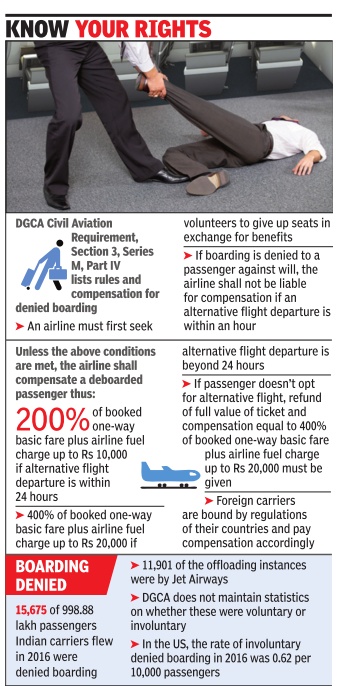
While Indian carriers have never done a United Airlines on passengers they have had to offload, about 15,000 passengers were denied boarding last year, and three of four of such flyers were booked on Jet Airways.
In India, the ratio of passengers offloaded each year is way below the global average.Last year, the ten carriers in the Indian airline industry flew 9.98 crore passengers. Of this, 15,675 were denied boarding or offloaded by carriers, according to the Directorate General of Civil Aviation (DGCA). Jet Airways's figure was 11,901 passengers (out of 1.89 crore it flew in 2016). Between December 2016 and February this year, out of 8,150 flyers offloaded by Indian carriers, 7,266 were Jet Airways passengers. A distant second was Air India (808).
Low cost airline IndiGo, which flew the highest number of passengers (3.9 crore), offloaded only 23 in 2016. That is largely because unlike Air India, Jet Airways and Vistara, which are on the Global Distribution System (a ticketing system that allows overbooking), the system used by IndiGo doesn't permit it to oversell. Compared to the global industry average, Indian carriers have pretty low rates of offloading. According to data from the Department of Transportation, US, 40,629 passengers were denied boarding involuntarily on domestic US flights in 2016. Southwest Airlines had the maximum number of such cases (14,979).
In India, the DGCA does not maintain separate data on whether passengers were voluntarily or involuntarily offloaded. Its norms state that an airline should first seek volunteers and compensate them (see graphic). If boarding is denied to passengers against their will, they should be compensated.
Apart from providing ho tel accommodation (wherever applicable) and booking the passenger on another flight, Indian carriers paid a total of Rs 6.35 crore in compensation for denied boarding last year. Jet Airways alone paid Rs 4.75 crore.
So if you are booked to fly Jet, it would be prudent to do a web or mobile checkin before you reach the airport, print the boarding pass, and most importantly , reach the airline check-in counter early .
Cartelisation
Competition Commission of India fines Jet Airways, IndiGo, SpiceJet/ 2018
CCI fines 3 airlines for cartelisation, March 8, 2018: The Times of India
The Competition Commission of India (CCI) has collectively imposed a fine of over Rs 54 crore on three airlines — Jet Airways, IndiGo and SpiceJet — for allegedly taking concerted action in fixing and revising fuel surcharge (FSC), a component of freight charges. The order came on a case filed by Express Industry Council of India against Jet, InterGlobe Aviation (IndiGo’s parent company), SpiceJet, Air India and Go Airlines, alleging cartelisation.
CCI order says Jet, IndiGo and SpiceJet “acted in a concerted manner in fixing and revising the FSC rates and thereby contravened the provisions of Section 3 of the Act, which prohibits anti-competitive agreements including cartels”. Accordingly, penalties of Rs 39.8 crore, Rs 9.5 crore and Rs 5.1 crore were imposed upon Jet, IndiGo and SpiceJet, respectively. In addition, a cease-and-desist order was also issued against the airlines.
A Jet Airways spokesman said it is yet to receive any formal communication from the concerned authorities regarding the development and is therefore unable to comment on the same. Other airlines did not comment on the issue till the time of going to press.
The CCI slammed the airlines for using FSC as a pricing tool, which was essentially introduced to mitigate the fuel price volatility.
Charter flights/ private jets
Dec 2017: rules liberalised
Saurabh Sinha, Flying out of India to get easy for HNIs, December 8, 2017: The Times of India
Aviation authorities have decided that India-registered charter flights or private jets will not need to adhere to the pre-condition of taking clearance from the regulatory agency (called YA number) to fly out of the country from December 15. The regulator is likely to extend this relief to foreign-registered charter flight or private jets by January-end. The operators will just have to file their flight plan with ATC to go abroad. This will add to the ease of doing business.
Currently, a maze of rules poses hurdles to flyers. The situation is worse if last-minute travel plans are made on weekends, when government offices here are closed.
The Indian charter industry is relieved at the prospect of YA number being done away with. Business Aircraft Operators’ Association (BAOA) president Rohit Kapur said that YA number was a requirement unique to India. “Doing away with YA will ensure operators can fly overseas without delay and this will also free up DGCA resources.”
In April 2016, Thomas Flohr, founder and chairman VistaJet, one of the world’s largest private jet charter companies, could not get permission even to overfly India on his way from Myanmar to Dubai as his aplication was made on a Friday. His flight on a Monday had to circumvent India, leading to an extra three hours of flying.
Compensation
Compensation for delays, accidents
Mar 19 2015
Flyers set for higher payoffs from airlines
Accidents, delays to cost carriers more
The Narendra Modi government has enhanced the compensation that airlines must pay passengers in case of lost baggage or suffering an injury while travelling with them. If a person dies or suffers bodily injury in an air crash or some other aviation-related accident, the compensation payabale to the family is now Rs 90 lakh, up from Rs 75 lakh earlier.
In case of inordinate flight delays, the compensation could now be as high as Rs 3.5 lakh, up from Rs 3 lakh earlier. The maximum compensation for lost baggage has now been upped to about Rs 84,000 from Rs 74,000 earlier.
The enhanced compensa tion comes with the Cabinet on Tuesday amending the Air Carriage Act that deals with issues like damages to be paid for flight delays, loss of baggage and accidental death. Indian carriers will now pay as their international counterparts, in line with the 1999 Montreal Convention that governs airline liability and compensation.
These compensations are based on something called special drawing rights (SDR), with each SDR worth $1.2.
In India, SDRs are converted into Indian rupees depending on the exchange rate at the time of payment. Damage in case of death or bodily injury for each person has been upped from a lakh SDR to 1,13,100 SDR. The liability in case of destruction, loss or delay of cargo has been raised from 17 SDR (Rs 1,265) to 19 SDR (Rs 1,400).
The change came as International Civil Aviation Organisation (ICAO) calculated that inflation had risen by over 10% -the trigger for a recalculation. In India, the change came with the Cabinet clearing an amendment to the Carriage by Air Act by inserting a new provision enabling the government to revise the limits of liability as and when the revised limits are notified by the ICAO. India had signed the Montreal Convention in May 2009. Also, the Convention stipulates that the compensation figures must be revised every five years.
Countries with flights to India
2016: Pakistan ranks 50th
Manju V, Of 55 nations with direct flights to India, Pak 50th, May 10, 2017: The Times of India
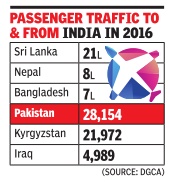
About 55 countries are air-linked to India by nonstop, commercial passenger flights, and if these nations were ranked on the basis of the number of passengers flying to and fro, Pakistan would be found holding a lowly 50th rank, ahead only of Kyrgyzstan, Iraq, Tajikistan, Reunion Island and Yemen.
Only 28,000 people boarded non-stop flights between India and Pakistan last year as against, say , the 8 lakh who flew between India and Nepal. With Pakistan International Airlines (PIA) suspending its Karachi operations to India, the neighbour is now set to fall to the bottom of that list this year. Currently, only PIA operates direct flights between India and Pakistan.
The last 189seater PIA A320 aircraft took off from the Mumbai international airport for Karachi at 2.40pm with 120 passengers on board. PIA's Lahore-Delhi is the only flight the carrier will operate to India now. The airline had said the decision to suspend the Karachi flights was a commercial one and not a result of the recent tension between the two neighbours. A look at DGCA statistics on the passenger traffic between India and Pakistan only corroborates that.
In 2016, 28,154 passengers flew between India and Pakistan on PIA's KarachiMumbai, Karachi-Delhi and Lahore-Delhi to and fro flights, a fall of 27% over 2015 (the data doesn't include passengers who fly between India and Pakistan via West Asia or other transit stops).
Among the top reasons for the abysmally low numbers is the comparatively cheaper road transport.
Crises
Challenges, in brief/ 2018
Jagriti Chandra, Why there is a crisis in the aviation industry, December 6, 2018: The Hindu
What is the crisis?
The three main publicly listed airlines in the country — IndiGo, SpiceJet and Jet Airways — slipped from profitability to steep losses in the first nine months of the current calendar year- 2018. These airlines together account for 70% of the domestic market share.
Why are they in trouble?
With crude oil prices having risen over the past year and a half, the cost of Aviation Turbine Fuel saw a 40% rise. Fuel accounts for the biggest expenditure for an airline — anywhere between 30 and 40% of the total expenditure incurred. At the same time, the rupee has seen a consistent fall and even breached 74 to a dollar in early October, though it has stabilised to a degree now. This meant that fuel costs apart, airlines were spending more on payments made in foreign currency for engine lease rentals, and maintenance and purchase of spare parts. Despite this rise in operational costs, the airlines have been unable to raise fares because of stiff competition among them. In fact, the lean months of July, August and September saw carriers wooing passengers with attractive offers in an attempt to fill up seats, as is the norm during this season every year.
As a result, by the end of September, market-leader IndiGo posted a loss of ₹6,52.1 crore — its first loss since being listed. The airline saw a nearly 60% rise in its expenses to ₹7,502.2 crore compared to the previous year. Of this, fuel expenses at ₹3,035.4 crore accounted for an almost 50% increase and the remainder was because of rupee depreciation and an inability to raise fares. Importantly, the cost incurred on fuel in the second quarter was double that in the same period last year.
To make matters worse, as airlines embark on a massive fleet expansion, there are more seats to fill than ever before, as many of these airplanes are pressed into service on the already popular routes. All domestic airlines have among them more than 570 airplanes as of now. IndiGo alone has climbed up from 77 aircraft in March 2014 to 198 until December 2018, growing 2.5 times in the past four years. A third of this capacity addition by IndiGo happened during the current calendar year. Altogether, domestic airlines will be adding over 1,000 planes in the next seven-eight years.
What does it mean for passengers?
An airline shutting down could impact connectivity and compress capacity on important routes and drive up airfares. Air travel is no more a luxury, but a necessity, and impacts the economy. So, possible airline failures will impact the public directly and indirectly.
However, experts say that an airline closing down is unlikely, though there could be a merger or a consolidation.
What lies ahead?
Short-term cyclical issues are unlikely to impact the long-term strategic outlook. India is the aviation market of the 21st century and experts see a profitable future for most Indian carriers, if infrastructure, policy and regulatory framework improve. According to the International Air Transport Association, the global aviation body, India will be the third biggest aviation market by 2024 after China and the U.S.
Defence airspaces
2015: Shortening routes over defence airspace
The Times of India, Jul 27 2015
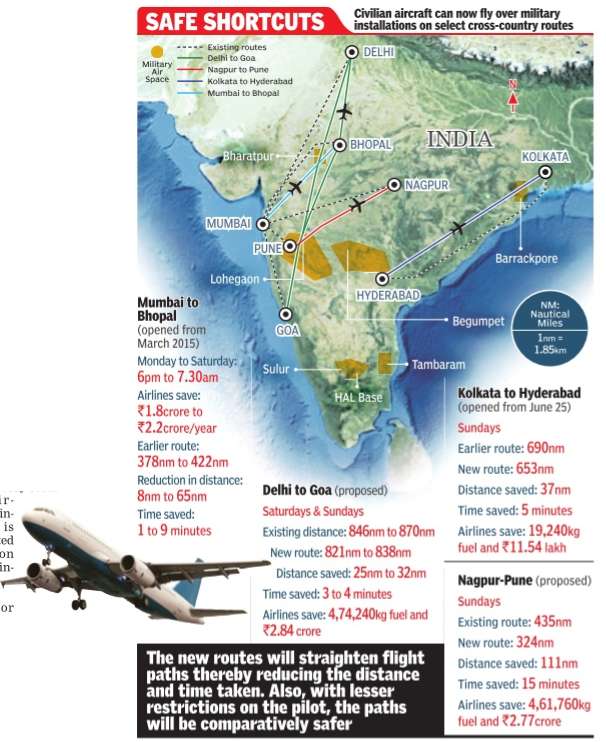
Ayyappan V
Flight time shortens as defence airspace opens
Airlines save on fuel and time by avoiding detours
A Kolkata-bound flight taking off from Hyderabad first flies eastward to reach the coast and then takes a northerly route with more deviations to reach its destination. The route has been designed to avoid military installations at Begumpet near Hyderabad and at Barrackpore near Kolkata. But with the restricted military airspace being opened up for civilian flights last month, pilots can now take a direct northerly path.
Airports Authority of India (AAI) has started implementing flexible use of airspace which allows civilian aircraft to fly over military installations. This allows airliners to save fuel and time besides avoiding unnecessary detours. In June, the Kolkata-Hyderabad route was opened and this saves almost 15 minutes of flying time. As this been successful, AAI is planning to allow flights to use military airspace on the Delhi-Goa route on weekends and on the Nagpur-Pune route on Sundays very soon. Military airspace, used for training and sorties, is marked as restricted areas on aviation charts . Civil airliners have to avoid such paths even when air force or navy planes are not flying. After much deliberation , defence ministry has decided to relax rules.
The proposal was made many years ago and was approved in 2013. Implementation has picked up momentum now. AAI has begun training air traffic controllers and staff, and has drawn up a manual to conduct route-specific trials between cities where detours are lengthier. The first was conducted between Kolkata and Jaipur.
An airline official said, “There was a training programme in Delhi in June. Another meeting was held in Hyderabad last week. The concept will improve safety as there will be less number of restrictions for pilots and air traffic controller.“
Chennai, though, has not been considered as of now since it is located at the farthest corner and does not fall between flight routes connecting major cities. The aim now is to eliminate detours of cross-country flights.
But Chennai would benefit if detours a flight takes before nearing the city airport come into focus. Flight paths over the city will be decongested if routes to the airport are designed to bypass the airspace used by Tambaram air force station and Arakkonam naval station. Flexible use of airspace will be beneficial for Benguluru and Chennai which are surrounded by military installations.
An AAI official said civil-military aviation cooperation is also being carried out as per the direction of International Civil Aviation Organisation which says that “shared use of airspace by civil and military aviation shall be arranged to ensure safety, regularity and efficiency of international civil aviation as well as the requirements of military air traffic.”
Delayed flights
Budget airlines to offer food: SC
Dhananjay Mahapatra TNN
The Times of India, July 9, 2011
New Delhi: Low-cost airlines cannot hide behind the “no free meal” clause printed on tickets to refuse food to passengers if the flight gets delayed by three hours. In an important judgment, the Supreme Court ruled that the exclusion clause not to provide meals would apply only to passengers who had not boarded the flight and were free to purchase food at the airport.
“It will not apply to passengers who are on board and a delay in the flight taking off denies them access to food and water,” said a bench of Justices R V Raveendran and A K Patnaik, while absolving IndiGo of any wrongdoing in a case of alleged ill-treatment of passengers on a fog-delayed flight in 2007.
“In the extraordinary situation where passengers are physically under the complete care and control of the airline, as it happens when they have boarded the aircraft and have no freedom to alight, the duty of the airline to protect and care for them-...would prevail over any term of contract excluding any facilitation, except when the carrier itself cannot access food due to emergency situation,” the bench said. “No public utility service can say it is not bound to care for the health, welfare and safety of the passengers because it is a low cost carrier,” said Justice Raveendran, who authored the judgment.
Three-hour delay will entitle flyers to food, says SC
Low-cost airlines must provide meals to passengers, who have already boarded, in case there is a delay in the flight taking off, said a Supreme Court bench of Justices R V Raveendran and A K Patnaik while absolving IndiGo of any wrongdoing in a case of alleged ill-treatment of passengers on a fog-delayed flight in 2007.
Female pilots
India has higher ratio of women pilots than global average
Manju V, Percentage of female pilots in local airlines on upswing, March 8, 2018: The Times of India
While it’s known that India has a higher ratio of women airline pilots than the global average, the percentage of female pilots in airlines such as Air India, IndiGo, Spice Jet and Jet Airways is on a steady rise.
Two days ago, IndiGo president Aditya Ghosh tweeted that 25% of the 1,200 women pilots in India work with IndiGo and they account for 14% of IndiGo’s pilots. At 12%, India has the highest average of women airline pilots against the global average of 4%, he had tweeted, referring to a December 2017 survey by the International Society of Women Airline Pilots.
National carrier Air India is one of the big recruiters of women pilots. An Air India spokesperson said 13% of its cockpit crew comprised women pilots.
Women comprise more than 12% of Jet Airways’ pilots, said a Jet Airways spokesperson. “The percentage of women pilots has been growing over time. About a decade ago, 7.5% of Jet Airways’ pilots were women. That number has grown over 12.1%, reflecting a progressive increase in women crew,’’ the Jet spokesperson added.
Another airline that is keen on increasing its women pilot number is low-cost carrier Spice Jet. On the eve of International Women’s Day, the airline announced a first of its kind initiative-—an exclusive recruitment drive for women pilots for its Boeing 737 and Bombardier Q400 fleet.
The airline has extended an open invite to women pilots across the country as part of the recruitment program held at SpiceJet training Academy in Gurugram on Wednesday and Thursday. “It is open for both captains and first officers having a valid commercial pilot licence,’’ said a Spice Jet spokesperson and added that an all-women selection board comprising the airline’s management lady pilots will conduct interviews. “With no exam fees attached, the hand-picked candidates will be given the offer letter the very same day.’’
2014-18: number doubles; exceeds twice the international ratio

From: Saurabh Sinha, Number of women pilots doubles to 1,000 in 4 yrs, September 26, 2018: The Times of India
INDIA HAS 15% OF WORLD’S WOMEN AIRLINE PILOTS
“Watch out Mr Trump, all our ladies are headed your way!” This message had gone viral on Air India pilots’ WhatsApp groups a few months back when the airline celebrated Women’s day by having allfemale crew on its nonstops to and from US. Twenty women pilots were deployed for the four routes to US that day — Delhi to New York, Chicago, San Francisco and Mumbai-Newark — apart from a SFO-Delhi direct. With 280 women pilots, representing 12.8% of its entire pilot workforce, the Maharaja did not have any difficulty in rostering them for flights to and from the US in one day.
The AI Group mirrors the growing number of women pilots in India which today stands at 12.4% with 1,092 of the total 8,797 pilots in schedule domestic airlines being ladies. India has, in fact, seen the number of women pilots almost double in last four years. In 2014, 586 of the 5,050 pilots (11.6%) in domestic schedule airlines were women. All ‘old’ airlines here have seen almost doubling of women pilots in this period.
In percentage terms, India has among the highest ratio of female pilots working for schedule airlines globally. In big aviation markets like US and Australia, the percentage of women pilots to the total workforce is about 5%. Estimates from the International Society of Women Airline Pilots published show there are 7,409 women pilots across the world accounting for 5.2% of total pilot workforce, said an airline official. According to the International Society of Women Airline Pilots, India has seen the maximum growth in number of women commercial pilots in recent times.
A woman pilot of an Indian carrier said on condition of anonymity: “We are breaking the myth of being bad drivers on roads in the sky. Very often passengers applaud either in flight or later on social media when they realize their flight was operated by women pilots. While Indian flyers know there are more women in flight decks than earlier, foreigners at times seem to be very surprised as they have a very old opinion of women in India.”
2018, India: women pilots twice, commanders 6x world average
Manju V, Percentage of desi women pilots twice that of world’s, November 9, 2018: The Times of India
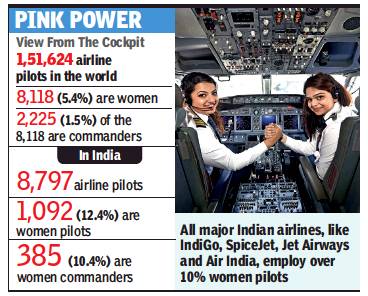
From: Manju V, Percentage of desi women pilots twice that of world’s, November 9, 2018: The Times of India
India not only has the highest percentage of women airline pilots in the world, but the percentage of women pilots in India is more than double the global average, according to latest data released by International Society of Women Airline Pilots (ISA+21).
According to the latest statistics, the percentage of women airline pilots in the world stands around 5.4%. In India, the percentage of women pilots currently is 12.4 %. India employs a total of 8,797 pilots of which 1,092 are women and 385 of these are female captains, according to ISA+21. Globally, the total number of airline pilots is over 1.5 lakh of which only 8,061 are women and 2,190 are women captains.
TOI was the first to report that the percentage of female pilots in India was way above the global average. In a report carried on September 11, 2006, TOI had quoted ISA+21 data which said that the global percentage of women pilots was 5.9%. Back then, the percentage of women airline pilots in India was 11%, which still was double the global average.
Delhi-based regional carrier Zoom employs the highest percentage of women pilots in the world, at 30%.
IndiGo has the second highest percentage of women pilots at nearly 13.9%. Of the 2,689 pilots that it employs, 351 are women. Of the 1,867 pilots in Jet Airways, 231 are women (12.4%). SpiceJet has 853 pilots of which 113 are women (13.2%), while Air India has 1,710 pilots of which 217 are women pilots (12.7%). IndiGo and Jet Airways are the only two carriers in the world, other than some US-based carriers, where the number of female captains is currently in three digits.
IndiGo has 118 women commanders and Jet Airways 100. However the percentage of women pilots in US-based carriers is just above global average.
An IndiGo spokesperson said, “In the past five years, the number of women pilots has increased from 80 to over 330. We have women pilots flying as trainers and some are in managerial positions as well. Two of our women pilots have been nominated as flight operations inspectors with the Directorate General of Civil Aviation (DGCA).’’ The official added: “IndiGo is the only airline to have crèches, which enable both women and men to strike a balance between their early parenthood responsibilities and professional obligations.’’
Government Policies
2016: New Aviation Policy

The Times of India, Jun 16 2016
Aviation policy puts small towns on the map for flyers
One may soon be able to fly to Bikaner or Bathinda, with the government aiming to put small towns on the aviation map and capping fares at Rs 2,500 an hour for locations that have so far been untouched by air connectivity . While there is a ceiling on fares, those flying from metros or large cities will have to pay a “small levy“ to fund building of no-frills airports.The Centre and states will chip in with funds and other concessions.
The plan, which has been in the works for the past few months, is part of the new civil aviation policy that was approved by the Cabinet. Announcing the policy , civil aviation minister Ashok Gajapathi Raju ruled out capping domestic air fares on existing routes, leaving it to market forces.
In addition, a new policy for helicopters, including setting up of four heliports, and allowing choppers to fly under 5,000 feet in unrestricted airspace without ATC clearance has been proposed in the new policy .
India is the fastest grow ing aviation market, clocking 22% rise in domestic traffic; the government hopes to increase the number of flyers to 30 crore by 2022, from eight crore currently. The new aviation policy announced on Wednesday aims to step up the growth rate and boost tourism while making air travel affordable for the aam aadmi.
“Regional connectivity, where the capping of fares has been announced, will benefit flyers greatly. For instance, there are no flights between Bangalore and Mysore simply because there is no passenger load factor. It's a 30 minute flight. If the fare costs Rs 1,200 many would prefer to fly,“ said Sudhakara Reddy, president of consumer group Air Passengers Association of India.
Aviation secretary R N Choubey said distance from airports was one of the key factors deterring people from flying to smaller towns. “NDA govt clears India's first ever integrated National Civil Aviation Policy. This will be a gamechanger for the sector... Regional Connectivity Sche me (RCS) --to revive unserved airports and routes in Tier II III cities,“ Raju tweeted. His deputy, Mahesh Sharma said the government would look to build 5080 no-frills airports across the country, many of them using airstrips that had been abandoned after World War II.
Each such airport is expected to cost between Rs 50 and Rs 100 crore and would come up in states which offer lower VAT on aviation fuel, provide police and fire services free of cost and supply power and water atconcessional rates.
On its part, the Centre will offer lower service tax and bear 80% of the burden to make flying to these destinations financially viable.But the key will be lower state levies on fuel as it accounts for nearly half the fare, Choubey told reporters at press conference.
States levy as much as 25% high value added tax on aviation turbine fuel, pushing up fares.
2017: no.3/ 4.7%
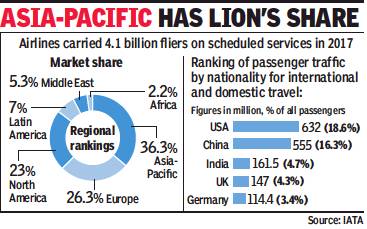
From: Saurabh Sinha, Among fliers, Indians were 3rd largest nationality in ’17, September 8, 2018: The Times of India
Americans (18.6%) & Chinese (16.3%) Ahead Of Desis (4.7%)
Indians were the world’s third largest air travellers (by nationality) last year. The International Air Transport Association (IATA) on Thursday released World Air Transport Statistics (WATS) for 2017 in which it has added ranking of passenger traffic by nationality, for international and domestic travel, where the flyer’s citizenship as opposed to the country of residence has been taken into account.
In all, IATA said over 400 crore passengers flew on schedule services (domestic and international combined) last year. American nationals were the biggest chunk of this at 63.2 crore (18.6% of all passengers), followed by Chinese at 55.5 crore (16.3%) and then Indians at 16.1 crore or 4.7% of all passengers. UK and Germany were behind India at 14.7 crore (4.3%) and 11.4 crore (3.4%), respectively.
Being a new addition to the World Air Transport Statistics (WATS), no comparable IATA nationality-wise statistics were available for 2016.
But according to combined domestic and international flyers, India was at number four according to CAPA Centre for Aviation data. In 2016, the combine figure was: Domestic plus international passengers in 2016: US: 81.5 crore; China: 49 crore; Japan: 14.1 crore; India & UK: 13.1 crore and Indonesia: 11.6 crore.
India had become ether world’s third largest domestic air travel market in 2016 when it overtook Japan, according to CAPA. US, followed by China, are the world’s biggest domestic aviation markets by a wide margin.
2018: India fastest growing domestic market
India fastest growing domestic aviation mkt for 4th year: IATA, February 8, 2019: The Times of India

From: India fastest growing domestic aviation mkt for 4th year: IATA, February 8, 2019: The Times of India
India was the fastest growing domestic air travel market globally in 2018 with the country seeing 18.6% more people flying within the country than the previous year. The International Air Transport Association (IATA) came out with the full year aviation data for 2018, which stated “India’s domestic market recorded the fastest fullyear growth rate for the fourth year in a row (18.6%)”, followed by China (11.7%).
“In both countries, domestic demand was underpinned by a robust economic expansion as well as by increasing number of domestic pairs — particularly in India, which recorded its 50th consecutive month of double-digit annual growth in October. In China, there have been some recent signs of slowdown in passenger demand, reflecting increasing concerns of a moderation in economic activity,” IATA said in a statement.
International routes
2018: India’s airlines among cheapest in the world
Manju V, Desi carriers top cheap int’l tickets chart, May 28, 2018: The Times of India
AI Express, Indigo In Top 5: Report
National airline Air India Express came second in a list of global airlines that offer cheap air tickets on international routes. Air India Express offered airfare that worked out to an average of Rs 5.4 per kilometre (USD 0.08/km) putting it at number two on the list of 200 airlines, according to the global flight pricing report released by Rome2rio, an Australian multimodal transport search engine.
AirAsia X, which flew passengers for as little as Rs 4.7/ km (USD 0.07/km) was the top airline for cheap international tickets. Three other Indian carriers, IndiGo (rank 5), Jet Airways (rank 12) and Air India (rank 13) that featured high on the list, had offered airfares that cost Rs 6.7 per kilometre (or USD 0.10/km) on the international routes, making Indian carriers among those that offer some of the cheapest fares in the world. But the rankings would appear counter-intuitive as some full service carriers share the same rankings as certain low-cost carriers that are notorious for aggressive pricing.
Apart from these three Indian carriers, a number of foreign carriers fell into the “USD 0.10/km” category and these included Etihad (ranked 6), Ryanair (ranked 7), Qantas (ranked 8), Virgin Australia (ranked 10), Oman Air (ranked 11) and WOW air (ranked 9), the Icelandic carrier which recently announced plans for entry into India with Rs 14,000 one-way fare from Delhi to 15 US cities with a stopover at Reykjavik.
In the list of top 200 domestic airlines that offer cheap tickets, IndiGo featured at the 15th spot, followed by AirAsia India at 18th and GoAir at the 20th. Vistara and Spice Jet took the 29th and 30th spot respectively.
The pricing report analysed over 1.5 million economy-class prices from 200 airlines with the average cost per km across the full list rising from 17.75 US cents in 2016 to 18.8 US cents in 2018, said a press release by the portal. The rankings were based on the price comparison between economy-class airfares displayed on Rome2rio in January and February 2018.
Flights over North Pole: AI first in India/ 2019
August 16, 2019: The Times of India
AI first Indian carrier to fly over North Pole
Air India became the first Indian airline to operate commercial flights overflying the North Pole when its Delhi-San Francisco flight, which usually flies over the Atlantic or the Pacific, cut across latitudes over 0° north.
AI-173, the Delhi-San Francisco flight, took off at 4am with 243 passengers on board, overflew Pakistan, Afghanistan, Kazakhstan, Russia and the North Pole by 12.27pm to cross over to the other side of the Earth.
The inter-continental trip took a total of 14 hours and 59 minutes, thereby saving 1 hour and 45 minutes as well as resulting in a decrease of carbon emission of up to 21 tons per flight.
1997,2007: poor; 2010-17
June 23, 2019: The Times of India

From: June 23, 2019: The Times of India
India doubled international departures in 7 yrs
International travel was for long seen as the preserve of the citizens of affluent European or North American countries. But that is changing fast and the poles as it were have swung with China accounting for the highest number of international departures for any country in 2017. India, too, features in the top of the global list and is tipped to grow faster than China when it comes to outbound travel from the country
DIAL can use vacant land commercially: HC
In a boost to the private operator running Delhi's international airport, the high court on Monday cleared the decks for it to utilise vacant airport land for commercial purposes.
A bench of Chief Justice G Rohini and Justice Sangita Rohini and Justice Sangita Dhingra Sehgal set aside a policy decision taken by the Centre to exclude IGI airport from the ambit of its 2016 national civil aviation policy .The policy liberalised the use of non-flying related land strips in an airport for commercial use. “Accordingly, the letter da ted 10.10.2016 of the Respondent No.1 (government) is hereby set aside and there shall be a direction to the respondents to take the necessary further steps in terms of the findings recorded by us in this order and to extend the benefit of liberalised use of airport land under clause 12(d) of NCAP , 2016 to the Petitioner (DIAL) in respect of IGI 0Airport on par with the existing and future airports of AAI as well as future projects under PPP ,“ the bench ruled, granting relief to DIAL. The private operator had approached HC challenging IGI's exclusion from the benefits of new aviation policy on the ground that only future private-public partnership projects are covered under the new scheme.
In its defence, the government maintained that NCAP has been initiated and issued in the national interest, kee ping in mind domestic and international passenger traffic for overall growth of national civil aviation.
But HC pointed out that exclusion of existing PPP airports from availing the benefit of the policy which would enable to develop the existing airports and to increase revenue to the public exchequer, “would be completely arbitrary and discriminatory .“ It added that “exclusion of existing PPP airports is also against the interest of the public at large since while the liberalised use of airport land by the AAI airports and future PPP airports will promote wider economy in the vicinity and benefit the passengers and the public at large in terms of overall development, the economic activity in the vicinity of the existing PPP airports would remain stagnant and deprive the passengers the same benefits.“
The court also reminded the government that DIAL is operating IGI Airport on behalf of AAI, rejecting the Centre's stand that IGI Airport is different from “AAI Airport.“
Laws and rules
The Air Corporation Act, 2016
The Times of IndiaJan 06 2015
The Air Corporation Act of 1953 nationalized the airlines industry in India.The liberalization of the sector started in 1986 when private players were allowed to run air taxis. In 1994, the Air Corporation Act was repealed and private companies were allowed to operate scheduled commercial flights.Airlines registered in India showed an impressive increase of over 600% in passenger volume between 1991 and 2013, when India was ranked 9th in the world in passenger volume. Among the 20 countries registering the highest passenger air traffic, the growth of civil aviation has been even higher over this period in the UAE, Turkey, Ireland and China
The Carriage by Air (Amendment) Bill, 2016
The Times of India, Mar 12 2016

Saurabh Sinha
Bill for higher air mishap damages gets LS approval
Parliament approved a bill providing for enhanced compensation to air travellers in case of death, injury , lost baggage or even inordinate delay in flights, with the Lok Sabha passing it with minor amendments. The Carriage by Air (Amendment) Bill was passed by the Lok Sabha in December 2015 and by Rajya Sabha, with minor amendments, on March 2, 2016. The bill, along with the amendments, came back to the lower House and was adopted by a voice vote. As per provisions of the bill, the compensation for death in an air accident will be calculated on the basis of Special Drawing Rights (SDR).The bill intends to raise the liability limit for damages in case of death or bodily injury for each person from 100,000 SDR to 113,100 SDR. The currency value of the SDR is based on market exchange rates of a basket of major currencies -US dollar, euro, Japanese yen and pound sterling. As per the latest exchange rate, the compensation limit rises to more than Rs 1 crore. One SDR is equivalent to around Rs 93 at present.
The bill also proposes to raise the liability for delay in carriage for each person from 4,150 SDR to 4,694 SDR, while the liability in case of destruction, loss, damage or delay of baggage will be raised from 1,000 SDR to 1,131SDR.
India's aviation security regulator is all set to get more teeth, with the government sanctioning a three-fold increase in the manpower of Bureau of Civil Aviation Security (BCAS) to take it from 190 to 600. “The impact of this move will be that BCAS will have presence at all airports. As of now, we have eight regional offices. This number will go up to 20. The regulatory agency will be reorganised and revamped,“ said an official. The recruitment for the additional posts has begun. But the government will have to make a start by appointing a person to head BCAS. B B Dash, joint commissioner, has been officiating as the commissioner of the agency. But his five-year term gets over in three months..
Photography
“Air side“ photography
Saurabh Sinha DGCA bars clicking pics near aircraft Sep 15 2016 : The Times of India (Delhi)
Flyers will no longer be allowed to take pictures or selfies while boarding or alighting from aircraft. The Directorate General of Civil Aviation has reinforced restrictions on “air side“ photography by passengers in a new rule issued primarily to prohibit pilots from taking selfies in cockpits of airborne planes as the regulator has found the latter to be a major distraction that could affect safety .
A DGCA air safety circular issued on August 29 has asked airlines to ensure that “passengers do not indulge into photography while embarkingdisembarking from aircraft.“ Also, passengers will no longer be able to request crew to let them in the cockpit to click a quick selfie while disembarking. In fact, photography inside cockpit has been banned for crew also in all phases of flight and not just while flying.

From: Reeba Zachariah & Boby Kurian, Tata Sons chief to pitch for board’s backing to buy Jet, November 15, 2018: The Times of India
See graphic:
The domestic market share of India’s airlines, as in 2018, Sept
No-fly list
2017: rules formulated
Unruly passengers could be barred from flying for life, May 6, 2017: The Times of India
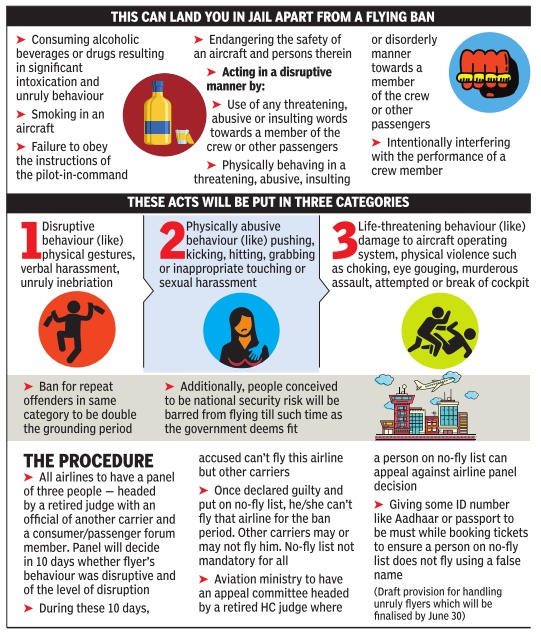
Aggrieved Flyers Will Have Option To Appeal Ban
Unruly behaviour on a flight -or even with airline staff on the ground -from June-end could mean a ban on flying for up to a lifetime. The aviation ministry presented the draft rules for India's first no-fly list (NFL) on Friday which puts disrup tive behaviour on board into three categories and prescribes different grounding periods for each level.
And to ensure that this provision is not misused against innocent passengers who may have been genuinely aggrieved by deficiency of service from an airline, the Centre has provided for appealing against the grounding order. However, Shiv Sena MP Ravindra Gaikwad's act of beating up an Air India staffer on March 23 -which led to the NFL -will not come under the purview of the proposed rules.
These proposals are in a draft civil aviation requirement (CAR) on which public comments can be sent for the next 30 days. After that, the ministry will examine them and it hopes to come out with the final rule before June 30. The first level of disrup tive behaviour includes “physical gestures, verbal harassment and unruly inebriation“. The next has “physically abusive behaviour“ like pushing, kicking and includes “inappropriate touching or sexual harassment“. The highest level is for “life-threatening behaviour, damage to aircraft operating system, physical violence such as choking, eye gouging, murderous assault, attempted or actual breach of “ cockpit.
“A passenger charged un der first level can be grounded for up to three months; up to six months under the second level and for third level, grounding can be upwards of two years with no maximum limit (meaning up to a lifetime). For repeat offenders in the same level, the period of grounding is proposed to be doubled,“ aviation secretary R N Choubey said. Grounding will be in addition to airlines filing police complaints against accused with its own consequences for the unruly flyers. Delhi Police, however, is yet to act on the complaint AI filed against Gaikwad.
All airlines will need to have a panel headed by a retired districts and sessions judge with a senior official of another airline and a member of consumer or passenger associationforum as members.Airline crews will file complaints of unruly behaviour with this panel which will have to decide on whether the passenger is actually guilty of disruptive behaviour and of which level in 10 days. During these 10 days, the accused flyer will be barred from travelling on that particular airline. The no fly list will be under the Directorate General of Civil Aviation (DGCA) and airlines will have to inform it who all have been placed on the same.
“Once this standing committee of airlines decides the case, the flyer will not travel on any flight, whether domestic or international, of that particular carrier depending on the period of grounding. However, it will not be mandatory for other Indian carriers to follow this list. Other Indian and foreign carriers can also ground a person on NFL for the same period,“ said Choubey .
The aviation ministry will set up an appeals panel -which will be headed by a retired high court judge with a senior airline official and a person from consumerpassenger association as member. A passenger found to be disruptive by an airline panel and grounded can appeal against the decision in this panel. However, he or she shall remain grounded pending the appeal which will also have to be decided within a fixed time frame.
2017, Sept: Rules issued
Unruly behaviour on a flight can now ground you for life , Sep 9, 2017: The Times of India
Reckless behaviour on a flight that endangers others on board could ground you for life. This is part of the rules for India's first ever “no-fly list“, issued by the aviation ministry on Friday and now in force.
The list cites three levels of disruptive behaviour. The first is for “unruly physical gestures, verbal harassment and unruly inebriation“ which can lead to a ban of up to three months. The second level is for “physically abusive behaviour (pushing, kicking, hitting and inappropriate touching)“ with a ban of up to six months.
The final level is for “lifethreatening behaviour, including assaults, damage to aircraft systems“ that can lead to a ban from two years to a lifetime. The ban will be doubled for repeat offences.
The list will have two components: unruly passengers banned by airlines and people named by the home ministry as perceived national security risks. There will be checks and balances to ensure that airlines do not have a free run and falsely label anyone -like a flyer making a genuine complaint -an unruly passenger and then ground him or her.
Asked if VIPs like MPs will also face these provisions, aviation minister A G Raju said, “Any flying human being (sic) on an aircraft“ will face these provisions. “The no-fly ban will be in addition to any statutory legal action that can be taken against the offender under existing laws.“ Minister of state Jayant Sinha said the government will soon come out with rules for providing a unique ID card number with PNR to book tickets to ensure that a person on the no-fly list cannot fly by fudging details. A person put on the list by one airline can still travel with other carriers as the rules that India has adopted are airline wise and this is not a national no-fly list.While it is not mandatory for other airlines (Indian or foreign) to ground a person on one carrier's no-fly list, they will have the option of doing so.
Pakistan’s airspace bans
The economics of overflight charges, of Pakistan’s 2019 ban
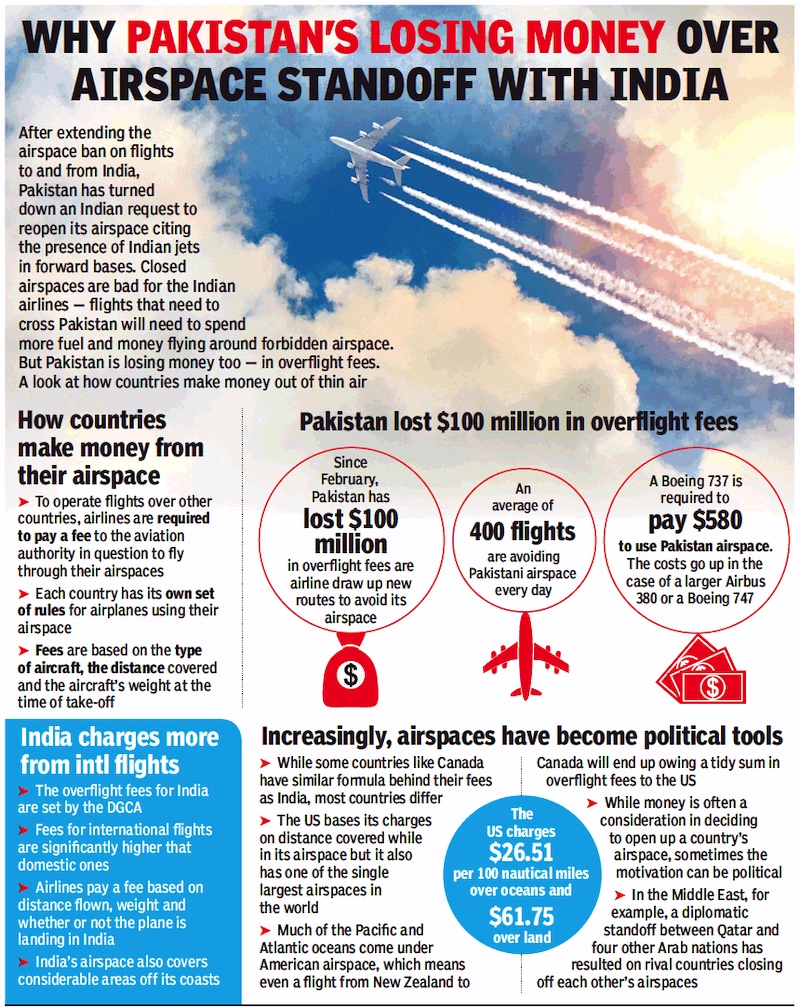
overflight charges, and
Pakistan’s 2019 ban
From: July 14, 2019: The Times of India
See graphic, ‘The economics of :
overflight charges, and
Pakistan’s 2019 ban ’
How the 2019 ban hit India’s airlines
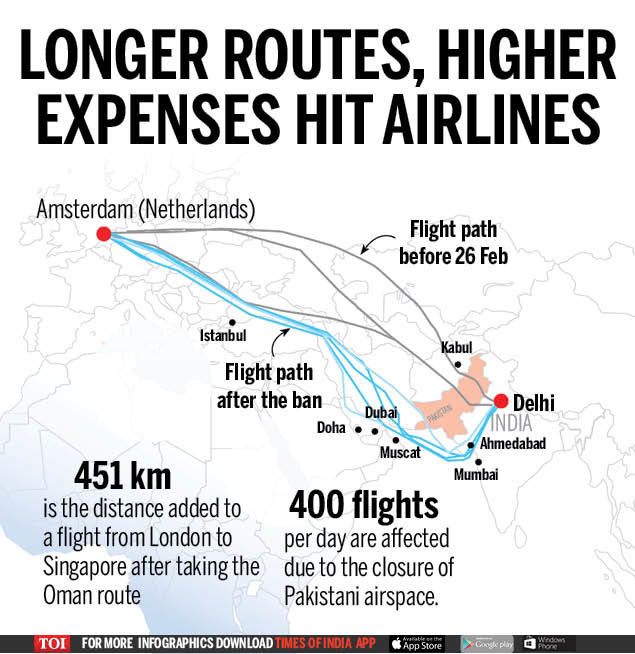
From: Saurabh Sinha,May 3, 2019: The Times of India
See graphic, ' How Pakistan’s 2019 airspace ban hit India’s airlines '
i) The issue; ii) Costs to India, Pakistan: Feb-July, 2019
July 4, 2019: The Times of India
Pakistan lost millions in airspace closure post Balakot strike: Here's how countries earn from thin air
NEW DELHI: While the closure of Pakistan airspace has hit Indian airlines hard + , having to re-route flights from India around the neighbouring country, thereby increasing the flying time and cost, it's impacted Pakistan as well, which has lost $100 million (around Rs 688 crore) since February with an average of 400 flights a day skipping the Pakistani airspace.
Pakistan closed its airspace + after the Indian Air Force's (IAF's) February 26 Balakot strike. Since then, it has only opened two of 11 air routes and both of them pass through southern Pakistan.
On its part, the IAF announced on May 31 + that all temporary restrictions imposed on Indian airspace post the Balakot strike have been removed.
So how do countries earn money, quite literally, from thin air?
An air toll: Airlines pay the civil aviation administration of the country they are flying over a certain fee based on the type of aircraft, the distance covered while overflying a country and the aircraft's all up weight (AUW) or gross weight, which is the weight of an aircraft before it takes off. In Pakistan's case, for a Boeing 737, the charges are $580 through its airspace — which will increase in case an Airbus 380 or Boeing 747 is flying over.
Are all airspaces as pricey? No. Canada, for example, charges on the basis of the airplane weight and the distance travelled while its southern neighbour, the US, charges only for the distance. However, the US can afford to be that generous considering its airspace isn’t just restricted to its landmass but extends all the way up to the Philippines — which means that a flight from Japan to New Zealand, which comes nowhere near the continental United States, will still end up paying @$26.51 per 100 nautical miles (roughly 185.2km) to the US FAA.
How expensive is India? The DGCA sets the overflight and landing charges in India, with domestic flights required pay less than international flights. The charges are calculated by multiplying the distance in nautical miles and the weight with a fixed charge component for airspace fees of Rs 5,330 if the fight lands in India. For those flights which are overflying, the charges are calculated on the basis of the route or the airspace fees, the distance and the weight, with an additional amount of Rs 5,080.
Due to closure of airspace by Pakistan, national carrier Air India lost Rs 491 crore till July 2 + , according to data presented by civil aviation minister Hardeep Singh Puri in Rajya Sabha. Private airlines SpiceJet, IndiGo and GoAir lost Rs 30.73 crore, Rs 25.1 crore and Rs 2.1 crore, respectively, the data stated.
Why do charges vary? Since 1944, when the US organised an international civil aviation convention in Chicago to try and hammer out an agreement between various countries to remove airspace restrictions for commercial flights — which failed, by the way — all the countries have charged according to their own whims and fancies for 'renting' out their airspace. In fact, air travel has become cheaper since 1990 with the opening up of Chinese and Russian airspaces which were till then off limits to airlines from non-Communist countries, such as the US and western Europe.
Is it about the money? While money is certainly a consideration in allowing overflight rights — the US, in 2016, by a conservative estimate that assumes just 100 nautical miles of overflying by the various airlines, earned close to $200 million from its airspace while a cash-strapped country such as Pakistan could do a lot with $100 million — there's also politics involved. Flights to and from Israel are not allowed the usage of airspace by the Arab countries while Bahrain, Egypt, Saudi Arabia and UAE have banned overflights by aircraft registered in Qatar due to its alleged support to terrorism. Other countries that have used their airspace as a political tool include China, which denies overflight rights to airlines from Taiwan.
Passengers’ profile
Women travellers from tier II, III cities: 2017
Women travellers growing from tier II, III cities: Report, Oct 29, 2017: The Times of India
HIGHLIGHTS
The age group of 25-34 years travelled the most
The preferences for top five domestic destinations remained similar to men, where Delhi topped the list followed by Bengaluru, Mumbai, Pune and Hyderabad
More and more women have begun travelling either in groups or solo and the trend is growing not just in metros but also tier-II and III cities, according to a report by Paytm.
The report, based on actual bookings on Paytm from April-September, said while 46 per cent of the women travelling solo or in groups belonged to tier-I cities, there has been a healthy contribution from smaller towns with 29 per cent and 25 per cent travelling from tier-II and III cities.
"It is very encouraging to note the healthy surge in the contribution of women travellers on our platform. Our latest report is a statistical evidence of increasing empowerment amongst women travellers and we believe it will encourage more and more women to venture out and quench their wanderlust," Paytm Vice President Abhishek Rajan said.
The age group of 25-34 years travelled the most, contributing more than 47 per cent to the total number of women travellers in India, followed by the 35-44 years age group (23 per cent) and 45-59 years (12 per cent), according to the report.
The preferences for top five domestic destinations remained similar to men, where Delhi topped the list followed by Bengaluru, Mumbai, Pune and Hyderabad. While it came to international destinations, most women preferred Dubai, Kathmandu, Singapore and Bangkok thanks to the cosmopolitan nature of these cities and the relatively higher concentration of Indian population, it added.
The report also found that women are likely to spend around 10 per cent more on travel tickets compared men.
The average travel duration of women travellers are also slightly higher at six days, it said.
After establishing the brand in online travel market, Paytm is looking to ramp up its team to 250 in the coming months.
It has sold over 10 million travel tickets in FY17, launched flight ticket bookings in July 2016 and is now among the top three players for online flight ticket bookings.
The company had launched railway ticket bookings in October 2016. In January this year, Paytm's travel business crossed USD 500 million.
Personnel Issues
Pilots suddenly taking mass leaves
Nov 08 2016 : The Times of India Report sick en masse, face licence cancellation, DGCA warns pilots Saurabh Sinha
The government is planning to clamp down on pilots suddenly taking mass leaves -usually by reporting sick together when facing an issue with their management. The Directorate General of Civil Aviation (DGCA) is proposing to cancel, either temporarily or permanently , licences of crew who resort to mass leaves “in public interest“ as these stirs lead to large scale flight cancellations. A draft civil aviation requirement titled “adherence to flight duty assignment by pilots“ says that airlines must immediately send doctors to homes of pilots when they report sick en masse.
The DGCA action comes after Jet Airways faced this issue earlier this month with its pilots and over a hundred of its flights were affected. The regulator then asked Jet to send a list of “habitual offender“ pilots. Other airlines, notably Air India and erstwhile Indian Airlines, too face this issue.
“It has been observed that pilots at times do not adhere to assigned flight duties that have a bearing on flight safety or public interest. Patterns have been observed wherein pilots rostered for flights report sick especially during times of festivals, weekends or at times during periods of disagreement with the management over issues of work terms and conditions,“ the draft CAR issued by DGCA acting chief B S Bhullar says.
And here's the warning for pilots: “Any act on the part of pilots, wherein they pretend to be sick to escape flight duty or report late to the aircraft. . . would be treated as an act against the public interest and shall attract enforcement action against them as per the provisions of the Aircraft Rules.“
Pilots who fail the breath analyser test
Saurabh Sinha, Pilot fails booze test 3rd time, grounded, August 5, 2017: The Times of India
A senior commander of SpiceJet was stripped of his flying rights after failing the breath analyser (BA) test for the third time. The commander used to fly Boeing 737 till the Directorate General of Civil Aviation (DGCA) cancelled his licence.
“DGCA has cancelled the Airline Transport Pilot's Licence... of SpiceJet commander who detected BA positive for the third time,“ said a senior DGCA official. On July 11, 2017, he failed the BA test for third time after operating a Mumbai-Delhi flight.
Comments from SpiceJet were awaited at the time of filing this story.
A pilot is grounded for three months, three years and forever after failing pre-flight BA test for the first, second and third time, respectively .Those failing the BA tests in post-flight checks get a year added to these groundings.
DGCA data says, the menace of drunk pilots seems to be on the rise in India. In 2016, 224 pilots tested positive in their pre-flight BA checks up 11% from the 2015 figure of 202. India had relaxed norms for tipsy flying by pi lots three years back. While a pilot now loses the flying li cence only when caught fly ing in an inebriated state for the third time, till mid-2014 this fate would befall them on the second instance.
The aviation safety regu lator in 2016 had for the first time directed registering of FIRs against two pilots and three cabin crew members of commercial airlines who were found tipsy after oper ating international routes in post-flight BA tests.
2016: 54% rise in docked crew
Unsafe skies: 54% rise in docked crew, Feb 04 2017: The Times of India
India may be the world's fastest growing aviation market but the country's skies are getting increasingly unsafe as the air traffic grows.
January-December, 2016 saw as many as 427 pilots and cabin crew of Indian carriers facing regulatory action for various safety violations like turning up drunk to fly or for being involved in accidents. This number was 54% higher than the regulatory action taken against 275 cockpit and cabin crew members in 2015. The figure in 2014 was a high 391 due to extra surveillance on private planes used for political campaigning.
“We have started a new system for doing safety checks based on risk assessment that led to this surge in detection of safety violations. Generally , we have heightened surveillance that led to a higher number last year. This included cases of crew flying more than the permitted number of hours,“ said a senior Directorate General of Civil Aviation (DGCA) official.
The regulatory actions are decided by DGCA's safety division that is headed by joint DG Lalit Gupta. Last year's safety drive saw the regulator directing filing FIRs against two pi lots (one each of Air India and Jet) and three cabin crew members (two of AI and one of Jet) who were found tipsy after operating international routes.
“Crew is suspended for reasons like failing BA tests for a maximum of eight weeks as airline crew is a precious resource and cannot be kept on ground for long. They are given corrective training and then fly again,“ said the official.
DGCA wants more punctual airlines
In a bid to clear the air on airline punctuality, the Directorate General of Civil Aviation (DGCA) is likely to recommend full automatisation of on time performance (OTP) recording mechanism at airports. The DGCA is studying the process of recording OTP at Delhi, Mumbai, Bangalore and Hyderabad after getting complaints from a carrier.
Pilots
2018>2019: Number of expat pilots soars by 176%
Chethan Kumar, March 7, 2020: The Times of India
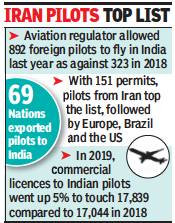
From: Chethan Kumar, March 7, 2020: The Times of India
The number of foreign pilots commanding aircraft operated by Indian airlines rose 176% in 2019 to 892 from 323 in 2018. These pilots are given what the Directorate General of Civil Aviation (DGCA) terms FATA (foreign aircrew temporary authorisation), which allows them to fly in India.
Country-wise data made public by the DGCA shows that of the 892 FATAs issued in 2019, at least 151, or 17%, were given to pilots from Iran, 100 to European countries, 71 to Brazil and 50 to the US. Pilots from 69 countries obtained FATA from DGCA. India has also welcomed pilots from Mexico (49), Myanmar (45), Honduras (31), Cuba (39), Nepal (27), Ukraine (20) and the African nations (19).
Given the perpetual shortage in type-rated pilotsin-command or commanders in the country, the number of FATAs issued by DGCA has been increasing by the year, and 2019 saw the highest jump in recent years.
From 139 in 2016, the number of FATAs increased to 184 in 2017 and jumped to 323 in 2018. “The provision of FATA, which was extended by two years in 2018, will expire in December 2020,” the DGCA says. The total number of FATAs issued in the past four years stands at 1,538. While an airline-wise data for the same was not available, aviation expert Devesh Agarwal said: “If you look at the influx of aircraft as planned by airlines, you will see that there will be an increase in ATRs, A320 and Bombardier q-400, among others. We don’t have enough commanders for these types of aircraft and I don’t see this to be alarming. An estimate going by the number of hours a pilot can fly and the number of hours one aircraft is used per year, you will see that each plane would need at least five commanders.”
The DGCA has not maintained information for years preceding 2016, but data for 2016-2019 shows the maximum number of pilots came from European countries. Iran stands out as a single country sending most number of pilots, followed by the US.
Punctuality/ on-time performance
2015

See graphic:
Status of airlines in India, July 2015: market share, occupancy, punctuality
2017
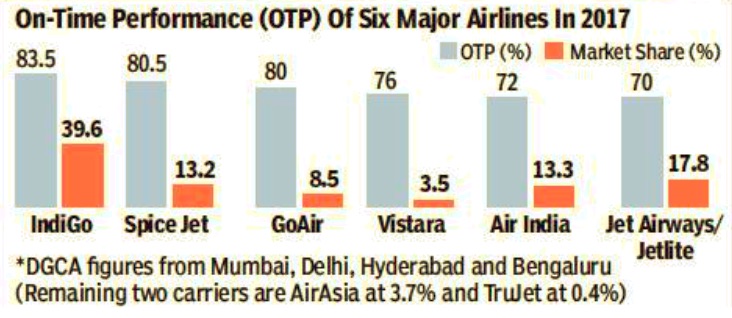
From: Manju V, 1/3rd of flights late, Jet was India’s tardiest in 2017, January 30, 2018: The Times of India
See graphic:
On-Time Performance of six major airlines in 2017
National carrier Air India is no longer India’s least punctual airline. Jet Airways’ on-time performance (OTP) was judged the worst in eight of 12 months last year, with as many as a third of its departures delayed. Jet Airways and Jet Lite carried 20.7 million domestic passengers in 2017. For the businessmen, industrialists, corporates and other frequent flyers among this lot, the airline’s poor punctuality record has turned flying into a pain.
According to data collected from-Mumbai, Delhi, Bengaluru and Hyderabad by the Directorate General of Civil Aviation (DGCA), until March 2017, it was Air India that largely had the worst OTP. However, in April and May 2017, Jet Airways fell to the bottommost slot, but recovered to fare marginally better than Air India in June.
Thereafter, Jet firmly stayed put at the lowest rung throughout 2017 to log a 70% OTP for its domestic flights.
Jet did not respond to a questionnaire sent by TOI. Air India (72%) was better than Jet, but not better than Vistara (76%).
The three together make up India’s entire cache of full-service carriers, the only airlines that offer frequentflyer programmes with privileges like zero cancellation and rebooking fees that frequent flyers count on.
India may be the third largest domestic aviation market in the world, but the downgrade in Jet Airways’ punctuality — alongside the mediocre show by Air India and Vistara — has meant that corporate India doesn’t have a single reliable full-service carrier to bank on.
In the past six months, scores of frequent flyers would have found themselves killing time at airports, missing meetings, engagements.
On Monday, till 10.40am, the departure gate screen at Mumbai airport showed that Jet’s 11am flight 9W 307 to Delhi was on time.
“Till 20 minutes before the scheduled departure, it kept saying ‘on time’. Then they suddenly announced it has been delayed to 12.45pm for operational reasons,” said a Jet passenger, adding, “Jet has become really bad. I’m sure there must be others like me who have begun to hate flying.”
2018 study
Saurabh Sinha, Flights reaching early slow down your takeoff, January 13, 2019: The Times of India
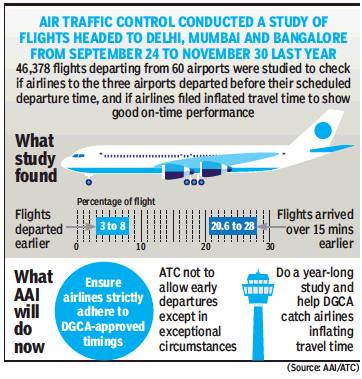
From: Saurabh Sinha, Flights reaching early slow down your takeoff, January 13, 2019: The Times of India
India’s three busiest airports — Delhi, Mumbai and Bangalore — are notorious for flight delays. While a crippling infra crunch at these hubs is responsible for you not taking off or landing here on time on most occasions, a study by air traffic control (ATC) has found airlines’ scramble for better on time performance (OTP) record by questionable means is adding to the problem of delays.
ATC carried a study at these three airports last year between September 24 and November 30, focusing on whether flights headed to these places as per the schedule from their origin airports, and what percentage of flights actually reach these airports at their slotted hour.
The study, covering 46,378 flights and accessed by TOI, found 2,569 flights or 5.5% left before their schedule departure time from over 60 origin airports for these three choked hubs. As many as 11,249, or almost a quarter, reached these three airports more than 15 minutes before their schedule departure time.
This meant these flights reached the choked Delhi, Mumbai and Bangalore airports at a slot which was not theirs, thereby affecting the flight which was supposed to be there at that hour. Consequentially, the flight supposed to be there at that time needed to either hover in air to land or on ground till a gate at the terminal is free to receive it.
“The reasons for the findings are: Airlines planning early departures; early pushback/departures and incorrect block time from gate to gate. (Block time is the time when an aircraft starts taxiing from the origin airport for take-off and then comes to a stop at its parking bay at destination airport),” said a senior official.
Airlines do this to show better OTP to attract passengers. Following the study, a the official said: “It has been decided to ensure airlines operate as per schedule. Flights will not be allowed to take off for choked airports before schedule time except when necessary. Airports Authority of India (AAI, parent organisation for ATC) will conduct a year-long study to find correct block times so that DGCA can catch airlines when they file inflated block times.”
Delhi and Mumbai handle almost 60% of India’s total aviation traffic. Once a flight gets delayed here, then all the other sectors it has to do that day face consequential delays. “While infra addition will take time, we will take interim measures to reduce delays and add flights in the meanwhile by taking these steps,” said the official.
2018: half of arriving flights at metros are late
It’s official now. The Airports Authority of India (AAI) has found that at least half the arriving flights to choked Indian airports like Delhi, Mumbai and Bangalore are not on time. A significant number of these noton-time flights turning up before their arrival slot at these choked airports when some other flight is supposed to be touching down there then, thereby delaying the latter. The authority has started a month-long trial where no flight, save exceptions, will be allowed to take off for choked airports more than five minutes before their schedule departure time.
“At capacity constrained airports (like) Delhi, Mumbai,
Bengaluru, adherence to approved departure and arrival slots is important to reduce air traffic congestion. However, recent air traffic analysis shows that at least 50% or more arrivals are not adhering to the allotted arrival slots, thereby, causing air traffic delay, congestion and occasionally diversions,” says an order issued by MC Dangi, AAI’s executive director (air traffic management), on Friday.
“It was decided that ATC should examine and devise a comprehensive solution to address the issue of early/late arrivals. This standard operating procedures is applicable to all airports from where scheduled domestic departures take place to capacity constrained airports. The above procedures will be in vogue for a period of one month,” it adds.
2018/ IndiGo and AirAsia India among top 20
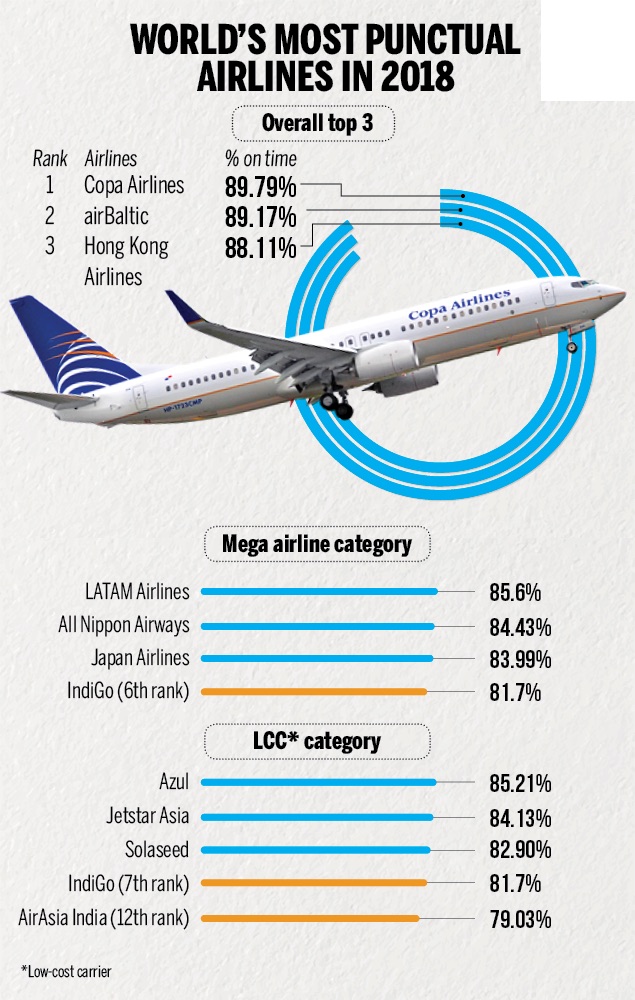
From: Saurabh Sinha, IndiGo, AirAsia India among world's most punctual airlines, January 4, 2019: The Times of India
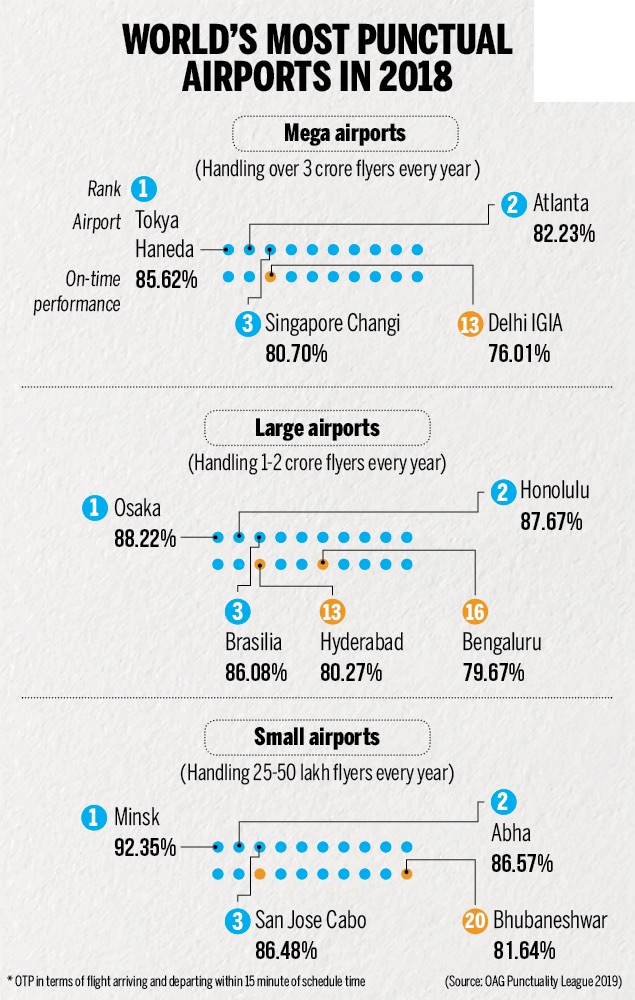
From: Saurabh Sinha, IndiGo, AirAsia India among world's most punctual airlines, January 4, 2019: The Times of India
Low-cost carrier IndiGo and AirAsia India are the only Indian airlines to make it to the top 20 most punctual airlines in 2018 across various categories. And, among airports globally with most on-time flights last year, Bhubaneshwar, Hyderabad, Bangalore and Delhi feature in the top 20 list in different categories. UK-based air consultancy firm OAG issued the “punctuality league 2019” based on 5.8 crore flight records using full-year data from 2018 to create a ranking of the best on-time performance (OTP) for the world’s big airlines and airports.
The ranking has been done by considering flights that arrive or depart within 15 minutes of their scheduled arrival/departure times. Airports handling at least 25 lakh passengers have been ranked according to their punctuality.
The overall list of 20 most punctual airlines across all categories — which has Latin American airline Copa on top —does not feature any Indian carrier. However, in the ranking done on basis of “mega carriers” and “LCC category” has IndiGo on sixth and seventh place, respectively. Among Asian Pacific airlines, IndiGo is at 10th place. Tata Group JV AirAsia India is 12th in ranking done on for LCCs.
Airports have been ranked on basis of passenger traffic they see annually. Mega airports, which see over 3 crore flyers annually, has Delhi’s IGIA at 13th spot with 76.03% flights here operating on time — almost at par with New York’s JFK hub.
Airports with 1-2 crore passengers in a year have been categorised as large airports. Two Indian airports — Hyderabad and Bangalore — are on this list at number 13 and 16, respectively with 80.27% and 79.67% flights being on time here. “While Chennai drops out, another Indian airport - Bengaluru - has made it into the Top 20 at 16th place,” the Punctuality League report says.
Among small airports, that handle 25-50 lakh flyers annually, Bhubaneshwar is placed at number 20 with 81.64% OTP.
Officials of Indian carriers and airports say Indian players could have done much better in the OTP rankings had aviation infrastructure been augmented here as traffic grew. “We were happy being the world’s fastest growing aviation market and did not give enough attention to adding airport infra in terms of giving new airports to place where existing airports are choked like Mumbai or Patna or and/or adding capacity in terms of more runways and bigger and new terminals in airports which still have scope to grow like Delhi’s IGIA,” said a senior pilot.
Delays at choked airports like Delhi and Mumbai are the norm now. And once a flight gets delayed at any big hub, all the other sectors it has to do that day are consequentially delayed.
Safety
India and the world, 2022
Dec 4, 2022: The Times of India
New Delhi: India’s aviation safety oversight mechanism is now among the top 50 in the world at the 48th spot — a quantum leap from its 102nd rank four years ago, reports SaurabhSinha. The International Civil Aviation Organisation (ICAO) —the United Nation’s aviation arm — had last month audited the Directorate General of Civil Aviation (DGCA) to check its effective implementation (EI) of critical safety elements and had given India’s aviation regulator its highest ever EI score of 85. 4%, which is a vast improvement from the last audit score of 69. 9% in 2018, where India was at the 102nd spot, with even countries like Nepal (101) Pakistan (100), Bangladesh (94) and Sudan (89) faring better. Now India’s EI score and rank is above that of countries like China (49), Israel (50), Turkey (54), Denmark (55) and Poland (60).
This is India’s highest ever ICAO EI score that measures compliance of all critical elements of aviation safety.
The strict enforcement action taken by the DGCA in the past few years reportedly went down well with the auditors. The improved safety ranking will make it easier for Indian carriers to expand their wings abroad. Tata Group’s Air India and IndiGo have massive expansion plans. Airlines of countries with poor aviation safety re- cords find their aircraft being subjected to more surprise checks at airports abroad.
DGCA chief Arun Kumar told TOI:“India fared extremely well in ICAO’s recently conducted ‘universal safety oversight audit programme (USOAP)’ and is likely to be placed in the company of ICAO contracting countries that are known for their high levels of aviation safety. However, we are still awaiting a formal communication from ICAO. ”
Security of flying aircraft
Bay of Bengal flights gets safer
The Times of India Jan 11 2016
Chennai
TIMES NEWS NETWORK
Flying over Chennai airspace has become safer for international flights as air traffic controllers can now track them better over the Bay of Bengal.
In a bid to enhance safety and monitoring of planes better, Airports Authority of India (AAI) has bifurcated the oceanic airspace, spread over 4 lakh square nautical miles till the Andaman and Nicobar Islands, into west and east regions.
The airspace is crucial for global air connectivity because 400 planes cruise along 14 international routes connecting Europe to Australia and the Far East everyday , over an expansive water body where tracking planes is difficult. This traffic is in addition to the domestic traffic from Chennai and Kolkata to Port Blair. Now, two dedicated teams of air traffic controllers will monitor planes flying in their respective regions so that they will not miss any flights in the airspace that is traffic-intense yet difficult to monitor because radar coverage is not efficient over such a vast area.The system will help overcome blind spots where air traffic controllers will not get signals showing movement o planes on their monitors.
Chennai has the largest airspace spread over the ocean where flights are cur rently monitored using voice communication with very high frequency (VHF) and high frequency telephony controller-pilot datalink, sat ellite phones and satellite based automatic dependent surveillance broadcast used as a backup for radar.
“The airspace has been made into two sectors based on traffic density and workload of controllers, traffic density and the number of points where air routes intersect. This will be implemented in three phases on trial and is expected to help airlines fly at their optimum level and save fuel and time,“ said a senior AAI official.
AAI board member for ANS A K Dutta inaugurated the facility on Saturday and said several such system were being implemented to help airlines cut down on fuel, operational cost and emission. AAI also introduced SMode operation to allow air traffic controllers to identify a plane as soon as they see a blip on their screens based on a code set by the crew.
2019: In bad weather over sea, pilots can’t call ground control
Ayyappan V, July 6, 2019: The Times of India

From: Ayyappan V, July 6, 2019: The Times of India
AB737-800 from Kuala Lumpur to Chennai has just entered Indian airspace. At 35,000 feet, the pilot radioed, “Which frequency we should try our luck today?”wondering about the plight in store for the next 1,600km of the flight over the Bay of Bengal.
This is the scene that has been playing out almost every day in past few weeks on the three busiest intercontinental routes used by planes to fly from Australia or Southeast Asia to Middle East and Europe as pilots struggle to contact Chennai air traffic control (ATC) while over Bay of Bengal. Pilots often fly blind for more than an hour or two over the Bay of Bengal because of poor signal from very high frequency (VHF) and high frequency (HF) channels used for contacting Chennai ATC. With weather rough on most of the days over the sea, pilots find it difficult to reach Chennai ATC for permission to deviate to avoid turbulence.
By the time contact is established and response arrives from the ground, often 15 minutes later, the plane has to just fly through dense clouds as unapproved diversions are not possible on the busy route.
“We often relay messages through other planes that fly nearby if they have a link. But not all pilots allow it for fear of getting it wrong. The channel for VHF and HF is clogged because too many pilots try contacting the ATC,” said a pilot.
On the Chennai to southeast direction, VHF is available for an hour into the flight. After that, pilots depend on HF. Still, planes fly for almost two hours in a no-communication zone.
However, flights do not go unmonitored. ATC sees them through a satellite-based datalink called ADS-B (Automatic Dependent Surveillance - Broadcast) which gets direction, speed, altitude of an aircraft from its transponder. But pilots said they have no means to speak to the controllers. “The channel should be split or they should improve the ground system to make the signals powerful,” said a pilot.
AAI has installed a VHF transmitter station in Port Blair with a range of 250 miles, but many pilots keep trying the Chennai frequency. “It is important to contact the controllers on the ground because sometimes weather deviations can be in the range of 100 miles when there is a weather system,” said a pilot.
An AAI official said ground system had been improved to make data communication and tracking of planes easier. “Airlines should install two-way data link system on planes to communicate with controllers because VHF and HF signals are prone to disturbances because of weather.
Boarding time of pilots; time gap between flights
Saurabh Sinha, `Ensure pilots board planes 20min before departure', June 3, 2017: The Times of India
India's aircraft accident investigator has asked Air India to ensure that its crew (read pilots) board aircraft at least 20 minutes before departure time and that a minimum time gap of 30 minutes be kept between two flights -an incoming and departing one -if crew from the former have to operate the departing flight.
The Aircraft Accident Investigation Bureau (AAIB) has also asked Air India to ensure that in the absence of pilots in cockpit, another pilot of the same airline who is travelling as a passenger on that flight should not be allowed to get flight (pre-take off) clearances.
These recommendations have been made in the AAIB probe report of an AI ground service engineer being sucked into the engine of an Airbus A-319 on December 16, 2015 at Mumbai Airport. The engineer had died on the spot. The three-member AAIB probe panel of senior officials, has asked the Directorate General of Civil Aviation to immediately implement the recommendations.
2017-18: Airbus 320NEOs grounded; 69 engine failures in Indi-Go
Manju V, 11 A320neos grounded after 3rd midair scare in 2 weeks, March 13, 2018: The Times of India
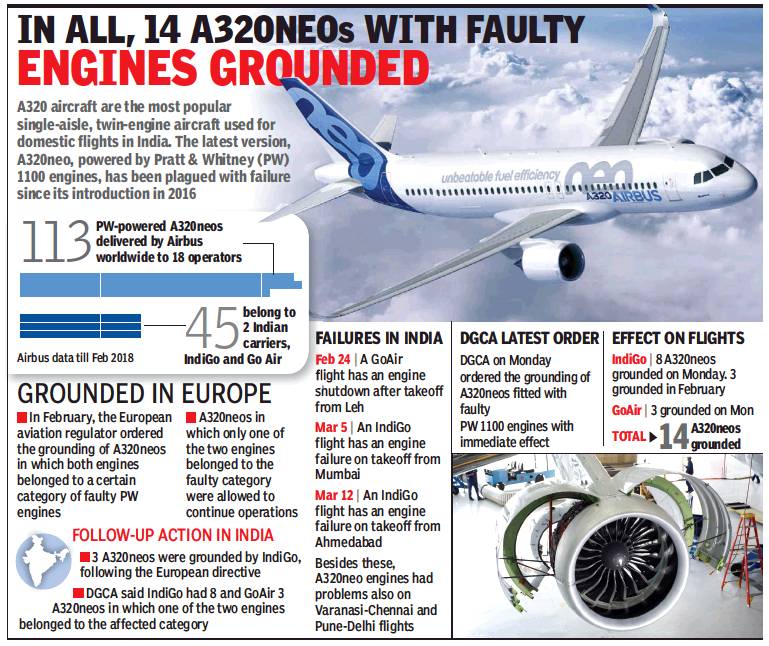
From: Manju V, March 13, 2018: The Times of India
Close Shave For Ahd-Lucknow IndiGo Flight
Hours after the third midair aircraft engine failure in two weeks, the civil aviation regulator ordered the grounding of 11 Airbus 320neo planes. This is expected to hit 75-80 flights operated by IndiGo and GoAir every day.
TOI was the first to report that 69 instances of engine failure were reported by Indi-Go in just 18 months till September 2017. The final incident that pushed DGCA, the civil aviation watchdog, into action occurred early on Monday morning, when the right engine of an IndiGo A320neo aircraft, packed to capacity with 186 passengers and crew, failed midair on the way from Ahmedabad to Lucknow.
The pilots radioed an emergency and the aircraft returned to touch down safely in Ahmedabad around 5.30am with ambulances and fire engines on standby.
Technical snags, 2017
Saurabh Sinha, Airlines question govt’s snag report, March 31, 2018: The Times of India

From: Saurabh Sinha, Airlines question govt’s snag report, March 31, 2018: The Times of India
At a time when air travellers are worried by the surge in engine troubles that led to grounding of certain planes in India, a bitter battle has broken out among airlines over their relative safety.
This war started after the government released data on snags suffered by different airlines last year. Three of India’s biggest airlines — Jet Airways, SpiceJet and Vistara — have questioned the basis of snag reporting as they say the number of faults reported by some (read IndiGo) is not commensurate with the number of planes in their fleets.
On March 13, the aviation ministry gave a written Parliamentary reply saying nine airlines had reported 24,791 snags in 2017 — 9,689 by Jet; 4,903 by SpiceJet ; 4,563 by Air India Group (including Alliance Air and AI Express); 1,888 by GoAir; 1,367 by AirAsia;1,225 by Vistara; 793 by Blue Dart; 340 by IndiGo and 23 by Zoom Air.
Questioning the system of reporting snags, as India’s largest airline IndiGo had second lowest number of snags to its name in this list, SpiceJet chairman Ajay Singh, Jet Airways CEO Vinay Dube and Vistara CEO Leslie Thng wrote a jointly signed letter to the aviation ministry saying: “It seems apparent that the number of technical snags being reported by various airlines is inaccurate. This discrepancy or misreporting of data is leading to a false illusion of the relative safety of some airlines over others.” An IndiGo spokesman said: “We have not seen this letter and therefore cannot comment on it. IndiGo strictly complies at all times with all reporting obligations as enshrined in the DGCA CARs (civil aviation requirements or rules).”
The joint Jet-SpiceJet-Vistara letter says: “Reporting of snags and defects is mandatory in India and accurate reporting of such snags is in interest of passengers and aviation safety. We request you to get this matter investigated by DGCA so that accurate information may be made available to Parliament and the public.”
Toilet habits
Long-haul flights delayed, airlines lose money
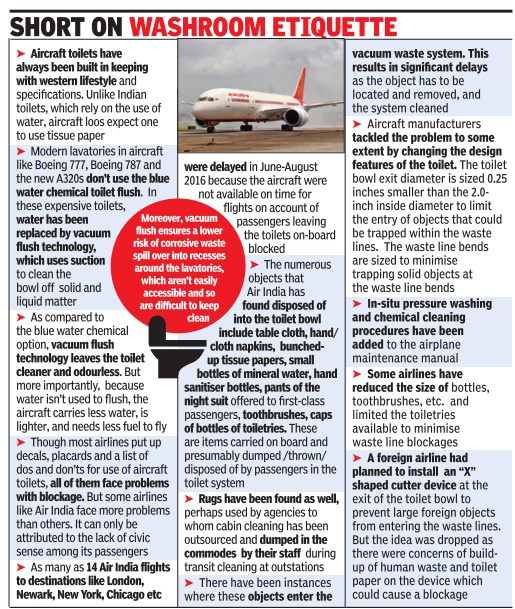
Commodes Clogged Often With Bottles, Cups, Diapers
Mumbai: Claustrophobic though it may be, once the door is shut and locked, an aircraft toilet turns temporarily into a sanctuary where a passenger can escape from the crowd and, often, lose the pretense of manners necessitated by the formality of air travel.
Unfortunately for airlines across the world, what a passenger does behind a closed toilet door can have a direct impact on their earnings. It's the one aspect that airlines have absolutely no control over, but decides whether the aircraft will depart on time for the next flight or, worse, whether it will be grounded for toilet repairs.
“If a passenger throws any object into the toilet, like a plastic bottle, soiled diapers, a bunch of tissue papers, it could damage its vacuum flush system. Then the object has to be located, it has to be removed and the flush system repaired. The next flight is delayed, the losses are multifold,“ said an airline source.
A senior AI cabin crew member said, “The older aircraft used the blue liquid chemical toilet flush system.When there was a blockage, we would pour hot water and then flush after some time and it would often clear the blockage. Now, newer aircraft such as the Boeing 777 and Boeing 787 have a vacuum flush which is advanced technology . But once these toilets are blocked, there is nothing we can do.“ When a toilet cannot be used, a log entry is made by the cabin crew. “On average, there would be 30-60 log entries a month by cabin crew about toilets that have been rendered useless by passengers who dumped bottles, rags or other such items into the commode,“ he added.
It was such “toilet abuse“, as airlines describe such cases, that is suspected to have triggered the headline-grabbing fracas on Saturday's Delhi-Chicago Air India flight.When it departed, only eight out of the 12 toilets were functioning. En route the 17-hour flight, even the eight toilets went out of order. With no toilets to use, the over 340 passengers, including seven infants, had to stay put with bladders full till the flight landed.Whether AI maintained its toilets well remains to be seen.The AI spokesperson was not available for comment. But irrespective of whether the toilets were maintained well, the incident has brought to fore the issue of rampant toilet abuse by passengers, especially Indians, a practice AI has been a victim of for years now.
“In August last year, AI's Newark-Mumbai flight made an unscheduled stop in Istanbul as all the toilets were unserviceable. But it was particularly bad in 2016 between June 5 and August 23, when the toilets left blocked by passengers delayed 14 flights to destinations such as London, Newark, Chicago and New York,“ said an Air India official. These are all long-haul flights going to destinations with passengers that one could assume know how to use a toilet properly . But the reality is quite different. Anyone who has ever flown on an AI international flight would have seen that the toilets work when the flight departs, but as the hours fly by , there will be at least one toilet or two rendered unserviceable because of either unhygienic use or because it has been left blocked by a discarded object.
Lack of civic sense or culture gap?
An AI official said that airlines the world over face problems with clogged toilets, but not to the extent that Indian carriers do. The problem has as much to do with civic behaviour as it does with cultural differences. Aircraft toilets are made to western specifications, with toilet papers, while Indians are habituated to using water to clean up. “Some passengers don't have any concern for other users. They leave the toilet messy with water everywhere and worse, the paper cups and bottles used to fill water are dumped into the commode,“ he added.
Airlines are, meanwhile, doing all they can to curb such practices, carrying out awareness on their use through onboard announcements, demo videos and so on, even as they continue to spend more on repairs and maintenance.
Airhostess booked in Mumbai for theft
A 27-year-old crew member of an international airline has been booked for allegedly stealing silver jewellery worth over Rs 70,000 from a store at Mumbai airport's Terminal 2 in December and January. The store discovered the thefts in the second week of February.In the wake of the FIR, the woman secured interim anticipatory bail from a sessions court on the condition that she would honour police summons during their investigation. TNN
Ude Desh ka Aam Nagrik (Udan)
2017-Sept 18: 4.5 lakh flyers in 1.5 years
2 Airlines With Big Share Fail To Perform
Seventeen months since its launch, over 4.5 lakh people have flown on the government’s subsidised Ude Desh ka Aam Nagrik (Udan) where fares are capped at Rs 2,500 per hour of flying. The Airports Authority of India (AAI) has released figures from this regional connectivity scheme (RCS) from April 27, 2017, when it was launched in Shimla by PM Modi by flagging off an Air India Delhi-bound flight to September 23, 2018.
The number could have been much higher but for the dismal performance of two small airlines that bagged a lion’s share of RCS routes but have been unable to start flying majority of them.
According to the AAI data for the 17 months of Udan, a total of 15,723 flights were operated by seven airlines on about 60 routes. A total of 7.5 lakh passengers flew on these flights, of which almost 4.6 lakh took the subsidised fares.
The figures could have been much better had Air Deccan and Air Odisha performed better. Last March, the government had given award for 128 RCS routes out of which 50 and 34 were bagged by Air Odisha and Air Deccan respectively. However, the 17-month data made public by AAI shows both these airlines have operated very few flights on less than 10 routes each.
The 17-month AAI data says total number of passengers flown on RCS flights by Air Deccan and Air Odisha was 5,093 and 1,842, respectively. Even their combined passenger carriage of 6935 is less than 1% (0.9% to be precise) of the 7.5 lakh passengers who have flown on RCS flights.
The Shillong-Dimapur route awarded to Air Deccan and started on May 1, 2018, lists one as the total number of passengers flown till September
23. The return sector, Dimapur-Shillong, lists two as the total number of passengers flown on this route since launch. Contrast this with Alliance Air whose ATR-42 has been flying on Delhi-Shimla launch route of RCS since April 27, 2017. Due to runway length issues, the aircraft can’t have more than 35 people on board on Delhi-Shimla sector and not more than 15 on the return flight. Despite these limitations, Alliance Air has flown 14,041 passengers on this route.
“We are issuing notices to them to cancel the routes given to these two airlines and where they have not started operations despite giving repeated deadlines. Once these routes are taken from them, they will again be bid out. While there is no rule to bar these airline to bid for the same routes again, past performance of airlines will be a key consideration in award of those routes,” said a senior aviation ministry official.
Till now two rounds of bidding for RCS sectors have been conducted in which 328 routes have been awarded and of these 98 have been operationalised so far, said an official. The RCS figures managed to touch the 7.5-lakh mark thanks to Alliance Air which currently operates 10 routes.
NE, 2019: lack of passengers; private airlines abstain
Kangkan Kalita1, Nov 20, 2019: The Times of India
The Centre’s ambitious Udaan scheme that was meant to let common people fly at subsidised fares has failed to deliver in the northeast, which needed it the most to enhance air connectivity, given the difficult terrain in the region.
Of the 13 flights started in 2018 to connect some of the interior parts of northeast with key destinations like Kolkata and Guwahati, only two remain operational. The first flight under the international version of Udaan that was launched between Guwahati and Dhaka under the International Air Connectivity Scheme (IACS) on July 1 is also on hold due to lack of passengers.
Pulling out of private airlines from Udaan in the northeast has hit air connectivity between Tezpur (Assam) and Kolkata, Pakyong (Sikkim) and Kolkata, Pakyong and Guwahati, Lilabari (Assam) and Kolkata, and Lilabari and Guwahati.
The only two routes that have sustained in the northeast under Udaan to date are between Shillong and Kolkata and Jorhat and Kolkata.
The Airports Authority of India (AAI), which has been entrusted with the task of building necessary infrastructure for the successful operation of Udaan, has been caught off guard following the withdrawal of the “ambitious” airline companies from most of the routes.
AAI’s regional executive director Sanjeev Jindal said, “The routes in which the airlines have stopped operation under Udaan need to be handed over to established airline companies that can sustain operations in the northeast. They must not see aviation solely from commercial aspect, but as a social sector where connectivity has to be improved for the overall development of a region that has immense potential for growth.”
VT code
The Times of India, May 4, 2016
Many may not be aware of the origins of the term “VT“, which is the registration code of Indian aircraft.It is “Viceroy Territory“ and continues [till 2016] to be a legacy of the British Raj.
BJP MP Tarun Vijay demanded in the Rajya Sabha the government change this code.
Taking up the issue during zero hour, Vijay said, “India cannot be a territory of the Viceroy“ adding that the issue was raised in 2006-07 and 2008. But then civil aviation minister of UPA government had said, “It has been decided not to replace existing VT mark as no other code which distinctly identifies with India was available.“ VT code was given by International Civil Aviation Organisation. The BJP MP from Uttarakhand said that countries including Fiji, Nepal and Pakistan have changed their code, but India is still continuing with the VT code.
See also
Civil Aviation, India/ 1
